The imperial capital of Hue has been the capital of a unified Vietnam since 1802 after Nguyen Anh ascended the throne opening the Nguyen Dynasty, the last feudal dynasty in Vietnamese history. Hue ended its mission as the capital of Vietnam in 1945 when the last Nguyen emperor Bao Dai abdicated. Since then, the capital of Vietnam was once again chosen as Hanoi, the ancient capital of Hue became the ancient capital. Hue is a city located on the East coast, a central city located between two big cities, Hanoi and Saigon. The two neighboring provinces of Hue are Quang Tri and Da Nang. Hai Van pass connects Hue with Da Nang and the weathered boundary of the two regions. Together with Pho, you can summarize your Hue travel experiences with information about Hue hotels and motels, places to eat, delicious dishes in Hue, tourist attractions in Hue for your reference.
Table of Contents
The History of Hue
Anyone who has been to Vietnam once must have known that the climate in Vietnam is very different. While in the South it is usually tropical, in the North it is temperate. The climate in Hue is usually hot, humid and it is a combination of the northern climate and the southern coastal region. Hue is one of the regions with many cultural heritages. Up to now, there is no other area with a large number of relics but these relics still retain their original shape as in this ancient capital.
On the northern bank of the Perfume River is a relic of castles built in a defensive style forming an arc of 11km long. This valuable work includes more than 100 works of architecture, which has truly reflected the king’s life of the Nguyen Dynasty. Among the hills on the southern bank of the Perfume River are very beautiful tombs of Nguyen Kings. Among the most famous are the four tombs, each known with a name that matches the personality of each king and the architectural style of each. These are the majestic Gia Long Mausoleum, the majestic Minh Mang Duc tomb, and Magni Khai Dinh Tomb.
Hue is also an important center of Buddhism. In Hue and surrounding areas still exist, dozens of pagodas were built over 300 years ago and hundreds of temples and pagodas were built at the beginning of the century. In addition, Hue is also considered the origin of royal music and is home to many famous traditional dishes and fine craftsmanship.
It is the only city in the country that still retains the look of a medieval city and intact monarchy architecture. Hue has become a large and invaluable museum. Therefore, the government has ranked the monuments in the ancient capital of Hue as an extremely valuable asset and in December 1993 Hue was ranked by UNESCO as a world cultural monument.
When should travel to Hue?
If the climate of the country is divided into two seasons: dry and rainy, Hue has only two other seasons, namely the rainy season and the low rainy season. The rainy season lasts from September to the end of December, the less rainy season lasts from the end of December to around April. For the rest of the months, Hue weather is quite sunny because Hue is also in the abundant heat radiation and heat high. Tourists come to Hue at different times. If domestic tourists usually come to Hue from around early May to late September, foreign tourists come to Hue from October to the end of April. The most ideal weather in Hue is usually in November. Highlights Hue’s colorful culinary picture lows.
- Around March every year, Hue weather is still relatively cool now, it rarely rains, so you can go to Hue on this occasion, especially families with children and the elderly.
- On the occasion of April 30, Hue often organizes festival festivals with many unique cultural activities, in addition to this occasion there is also an international fireworks festival in Da Nang, you can schedule travel. Hue calendar combined with Da Nang tourism.
Guide to Hue
By Private vehicles
By Car
By Motorcycle
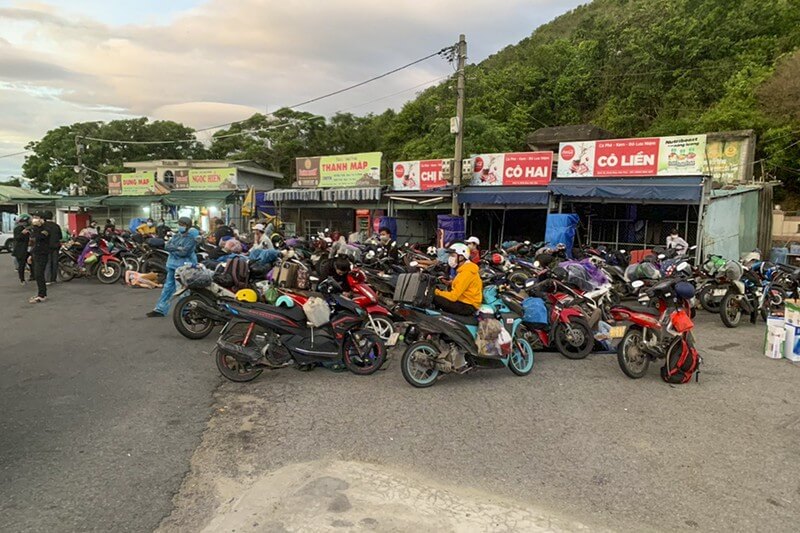
By Public transport
By Bus
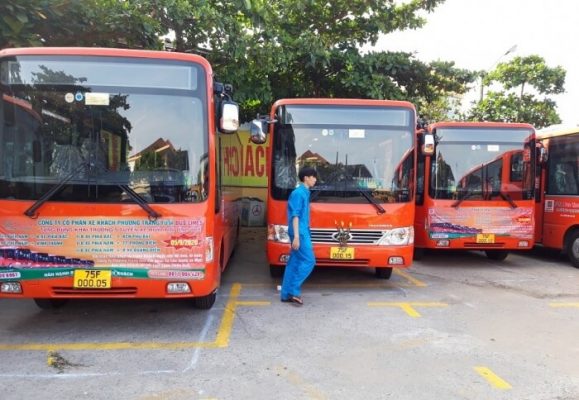
By Planes
Currently, from Hanoi, there are only 2 units, VietjetAir and Vietnam Airlines, operating flights to Hue, with Jetstar from Saigon in the afternoon, flight fare depending on time will be about 2,000,000 VND – 2,500,000 VND round trip from Hanoi and around 1,500,000 VND-2,000,000 VND with the afternoon from Saigon. Phu Bai Airport is about 40km from Hue city center, you can use the bus service to take passengers from the airport to the city center for about 50,000 VND / 1 person.
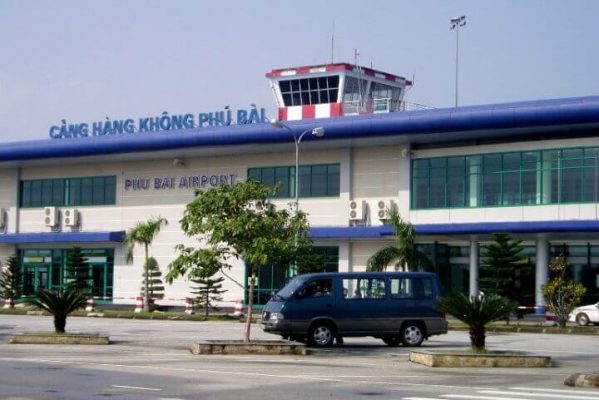
By Train
From the two ends of Hanoi and Saigon Station, there are 5 daily Thong Nhat trains departing for Hue according to the train timetable as below, depending on your plan, you choose the train time accordingly.
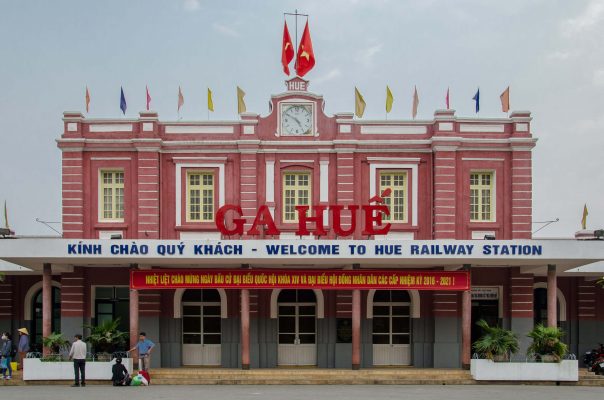
- SE1 and SE2 trains: [Hanoi 19:30 – Hue 8:48] [Saigon 19:30 – Hue 15:23]
- SE3 and SE4 trains: [Hanoi 22:00 – Hue 10:27] [Saigon 22:00 – Hue 16:39]
- SE5 and SE6 trains: [Hanoi 9:00 – Hue 22:42] [Saigon 22:00 – Hue 5:31]
- SE7 and SE8 trains: [Hanoi 6:00 – Hue 7:00 pm] [Saigon 6:00 – Hue 1:28]
- Train TN1 and TN2: [Hanoi 13:10 – Hue 3:39] [Saigon 13.10 – Hue 12:06]
In addition to the Thong Nhat trains, from Hanoi, there is the SE19 train to Da Nang, which departs from Hanoi Station at 8:00 am and arrives at Hue at around 10:00 am.
Find ways to get Hue easier with Bookaway!
By High-quality Passenger car
From Hanoi and Saigon, there are many high-quality bed buses every day to Hue, open tour buses to Hue, travel time is about 13 hours (from Hanoi) or 25 hours (from Saigon).
Transportation in Hue
By Cyclo
Cyclo in Hue is convenient because of its wide and high roof. When needed, it can carry goods or turn on the roof to transport passengers politely and safely. Nowadays, cyclo traffic service is the most attractive and suitable in the city. Using a cyclo vehicle, you can take a built-in roll around this ancient and beautiful city.
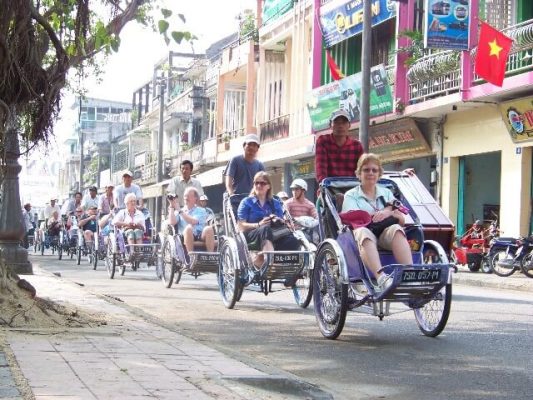
By Bicycle / Motorbike
With the advantage of being a tourist city, you can easily find an affordable bike or motorbike. The places for renting bicycles and motorbikes are concentrated on Hung Vuong Street, the distance from Truong Tien Bridge to Hung Vuong intersection with Nguyen Tri Phuong. The second area is Le Loi Street, West Quarter opposite Huong Giang Hotel, streets like Pham Ngu Lao, Chu Van An all have car rentals.
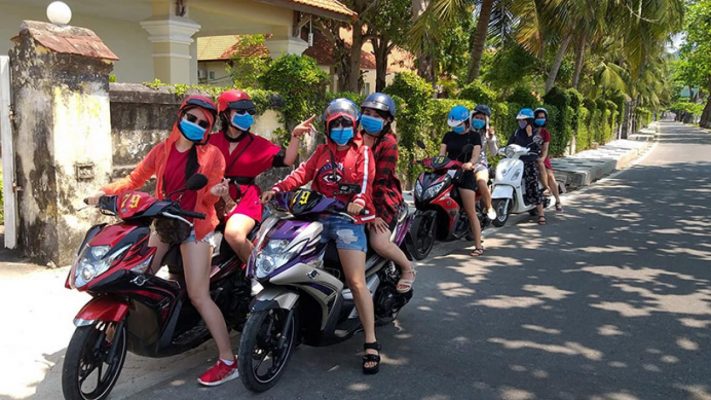
By Taxi
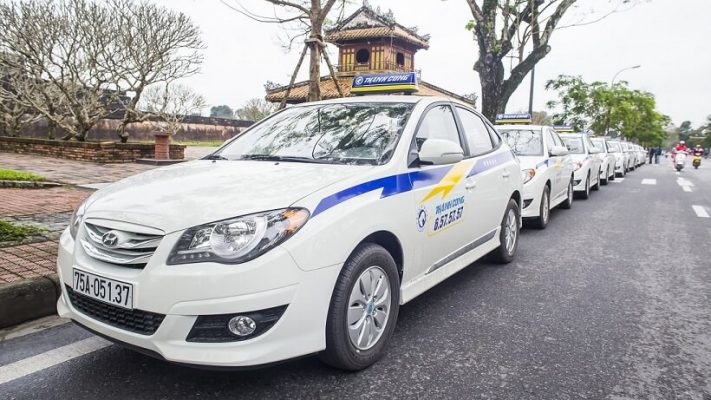
- Vinasun: 0234 3788 788 VND
- Mai Linh: 0234 3898 989
- Sun Taxi: 0234 3989 898
By Bus
Staying in Hue
Resort
If you want to find a quiet, isolated place to have moments of rest when coming to Hue, you will need to leave the central area. Some resorts are built near Thuan An and Lang Co beaches or Thanh Tan hot mineral springs area. If you stay here, you will often determine not to go anywhere because the long-distance travel, going back and forth many times is not really convenient and expensive.
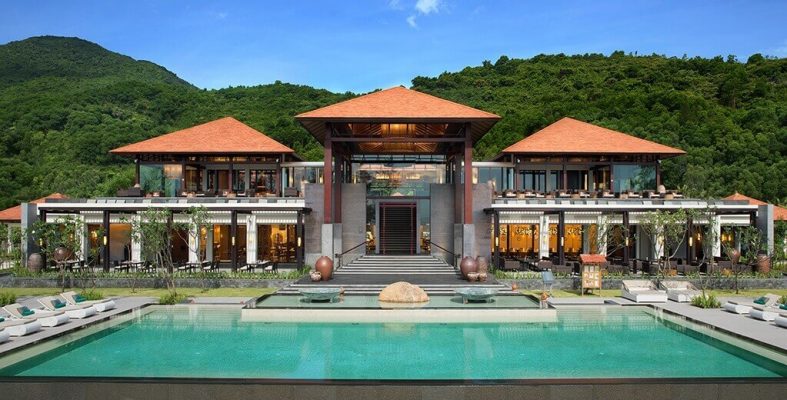
Hotels in Hue
Hue now has about 600 accommodation establishments with nearly 10,000 rooms, 17,000 beds, so there is almost no room fire in Hue.
For the majority of you traveling, often the need only needs a relatively reasonable place to stay because the whole time of the day is actually on the street, with this need, 2-star hotels are quite good and suitable because the price is relatively reasonable (usually only about 300,000 VND). If you want a little bit more quality (can usually be a nicer location, more complete room amenities) you can choose from 3-star hotels.
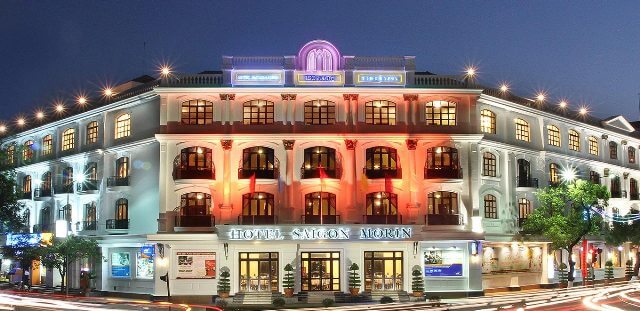
If you come to Hue in the summer, the weather is especially sunny and quite hot, most of you will want to be indulged in cool water for entertainment now. If you do not choose hotels, resorts near the sea (but far from the center) you can choose hotels with swimming pools in Hue. After a day of hanging out, going to the hotel and swimming is not a bad idea.
Finally, if you have economic conditions, why not try to stay and experience the services of 4-star hotels, 5-star hotels in Hue? Although the cost is high, it is sure that what you get will make you extremely satisfied.
Homestay in Hue
Meeting the needs of young people, those who love to travel but do not have a large budget, the form of accommodation at a local house was born, meeting the needs of beautiful space, good service, but the price is still reasonable. Unlike the traditional form of homestay, which requires sharing with the host, the new homestay style allows tourists to enjoy private space. Most of the homestay today are apartments separate from the owner. In particular, these locations are often beautifully decorated. Normally, a standard homestay will have a beautiful small garden whereby tourists will feel familiar, close, like at home.
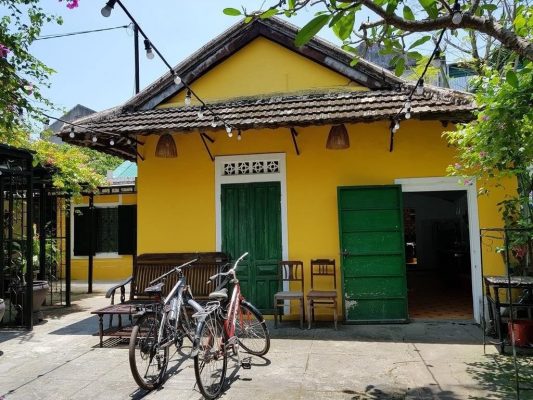
Sightseeing in Hue
Referring to Hue, people remember the gentle girl in purple robes and remember the city with a deep, idyllic but memorable beauty. Traveling to Hue, you will admire the ancient beauty of high-value historical sites located in Hue Citadel Complexes such as Hue Citadel, Tomb of Minh Mang, Gia Long Mausoleum, Thien Mu Pagoda, Van Temple, and School of Quoc Ho,… Let’s see the tourist destinations that cannot be missed when coming to Hue.
Tourist places in Hue
The complex of relics of the ancient capital
Hue Capital
Kỳ Đài
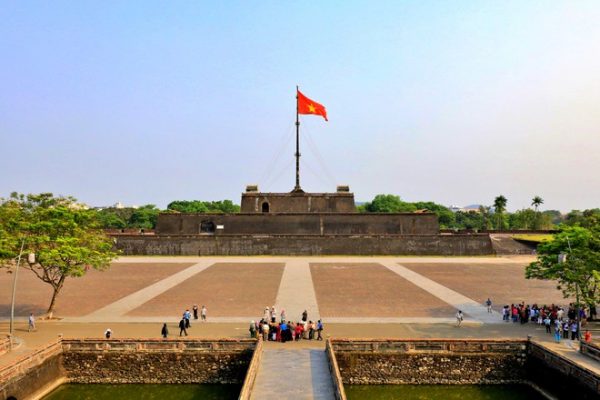
Cửu Vị Thần Công
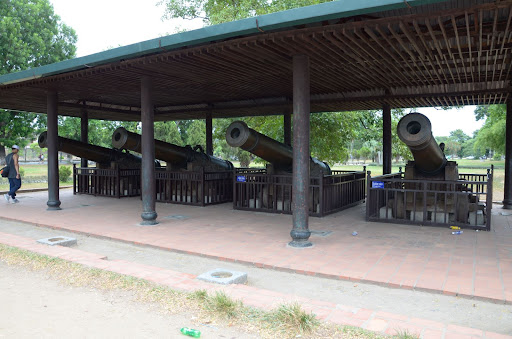
Hue Imperial Citadel
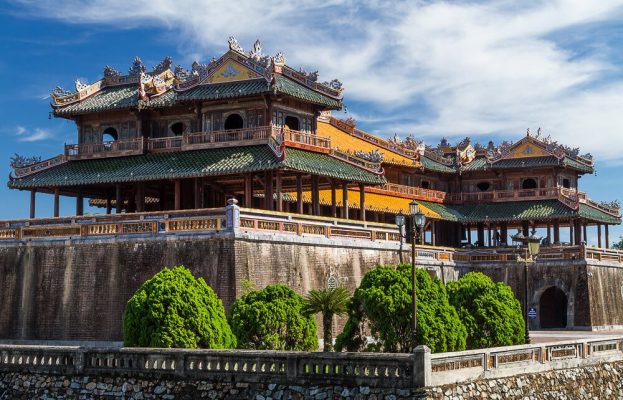
Tử Cấm Thành
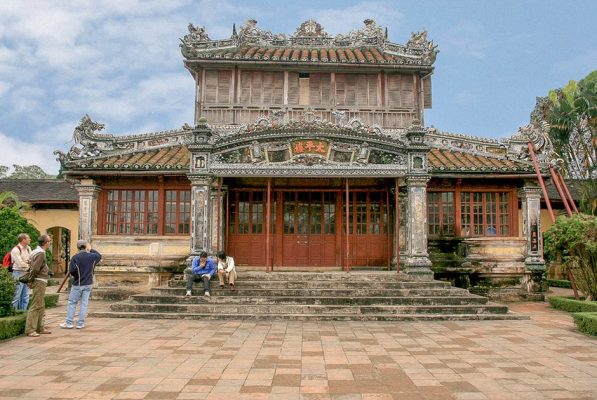
Museum of Royal Fine Arts
Museum of Royal Fine Arts is a museum at No. 3, Le Truc, Hue City. The main building of the museum is made of wood, has 128 precious wooden pillars, on the pillars are carvings of the four spirits: Long – Lân – Quy – Phụng and more than 1000 poems in Chinese characters. This building is the Long An Palace built in 1845 under the reign of Emperor Hien to the Nguyen Dynasty, the reign of Thieu Tri. Currently, the museum displays more than 300 artifacts made of gold, china, porcelain, and Hue traditional art, costumes of the Nguyen Dynasty, giving visitors an overview of Hue royal life.
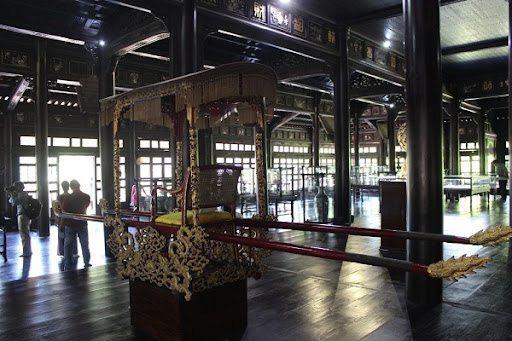
Ho Tinh Tam
Tinh Tam Lake is one of the famous landscapes of the capital city, now in the territory of Thuan Thanh ward, Hue city. In the past, the lake was a section of the Kim Long River that was reconstructed, the original name was Ky Te pond. In the 3rd Minh Mang year (1822), the Nguyen dynasty mobilized up to 8,000 soldiers to participate in the renovation of the lake, turning it into a royal residence. After completion, the lake was named Tinh Tam.
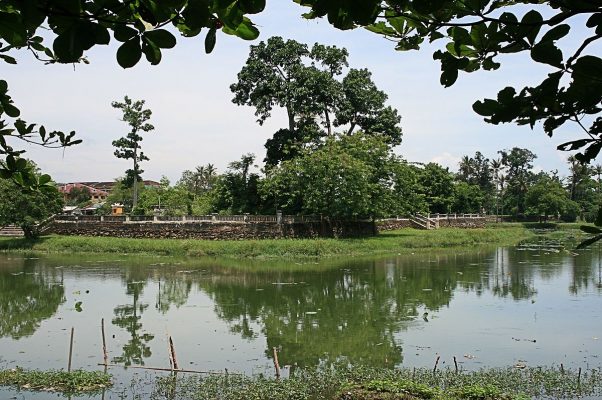
Tinh Tam Lake has a rectangular area, with a circumference of nearly 1500m (354 staff of 6 meters). There are three islands on the lake, Bong Lai, Phuong Truong and Doanh Chau. Bong Lai Island, in the south of the lake, in the middle of the lake is Bong Doanh Palace, 3 rooms with 2 wings, matching roof, Hoang Luu ly tile roofing. Electricity was built on the south side, surrounded by a brick railing, in front there was Bong Doanh gate, then Bong Doanh Bridge connects the island with the southern lakeshore. To the East of Bong Doanh Palace, there is the Thuy dynasty Thanh Tam, facing east. In the west, there is Trung Luyen floor, facing west. To the north is the Hong Cu estuary and a bridge of the same name.
On Phuong Truong Island, in the middle is Nam Huan guard, facing south, 2 floors, the roof is covered with royal tile. In the south, there are Bich Tao Gate and Bich Tao Bridge. In the north of the island, there is the Tinh Tam floor, built in the north. In the east, there is Hao Nhien (changed to Nature in 1848), facing east. To the west, there is a Duong Tinh patio facing west. Between the two islands, there is Tu Dat communal house located in the middle of a system of corridors with tiled roofs of 44 rooms, connecting to Bich Tao bridge in the south and Hong Cu bridge in the north.
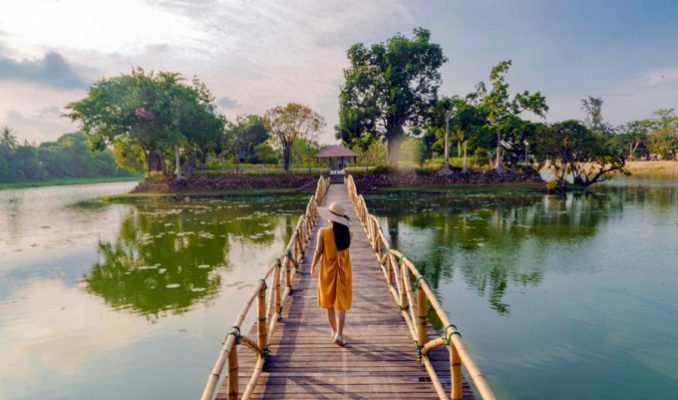
In the middle of Tinh Tam lake, there is Kim Oanh dyke connecting the east bank to the west bank. To the east of the dike, there is Luc Lieu bridge, 3 rooms with tiled roofs. To the south, the dyke is attached to a 56-room long corridor, in the middle is Bach Tan Bridge. To the south of the bridge, there is a barn Thanh Tuoc for the king’s boat. At the western end of the corridor is the Khuc Ta house, which is connected to another weightlifting house, Khuc Ta-Ha Phong through a small hallway erected above the water. South of this weightlifting house is Doanh Chau Island.
On the corners of Bong Lai, Phuong Truong, there are stone stacks to create imitation paints. Particularly, Doanh Chau Island is shaped like a large floating island on the lake surface. Everywhere around Bong Lai, Phuong Truong, Kim Oanh Dike, and along the lake banks are planted with willow and strange flowers. There is only one type of white lotus planted in the lake.
Tinh Tam Lake is separated from the outside by a rather high brick wall ring. Four doors have four doors: Ha Huan in the south, Dong Hy in the north, Xuan Quang in the east, and Thu Nguyet in the west.
With sophisticated architecture, but very in harmony with nature, Tinh Tam Lake is considered a typical achievement of Vietnamese landscape architecture art in the nineteenth century. The beautiful scenery of the lake created a source of inspiration and became the subject of many famous poems and poems of Nguyen kings such as Minh Mang, Thieu Tri, Tu Duc,… The most prominent is still the poem Tinh Ho Ha Hung in a series of poems praising the 20 beautiful landscapes of the Kinh land of King Thieu Tri. At the same time, this poem, along with the scenery of Tinh Tam lake, was painted in a mirror painting to hang in the palaces.
Since the late nineteenth century, due to the lack of care conditions, the architecture in the Tinh Tam lake area was gradually damaged or destroyed. In 1946, the brick wall ring surrounding the lake was demolished to construct a lower wall ring. In 1960, on the old foundation of Bong Doanh, there was a small octagonal house built to commemorate. During this restoration, a concrete bridge was built to connect Bong Lai Island with the Kim Oanh dyke,…
Đàn Xã Tắc
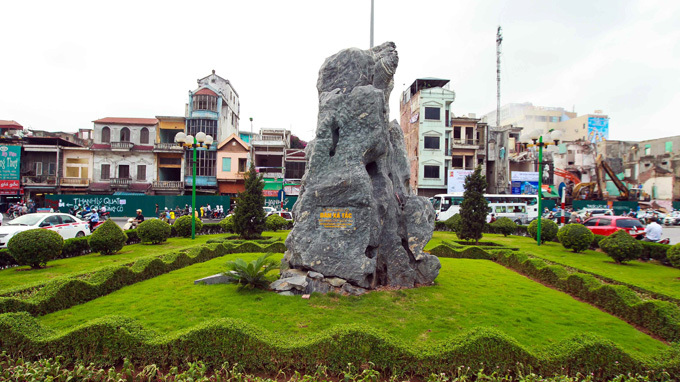
Phu Van Lau
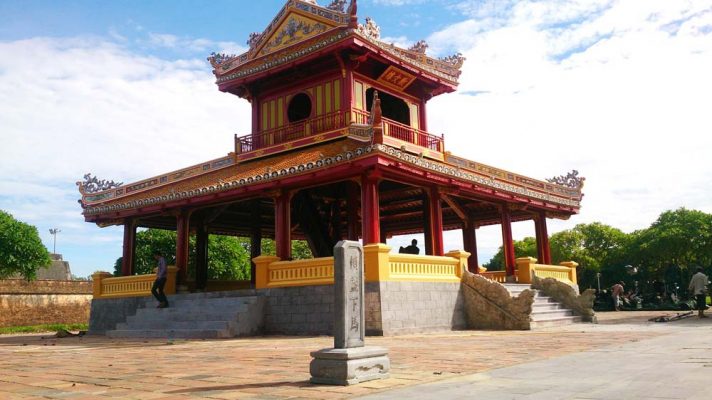
Hon Chen Palace
Ngoc Tran Mountain was formerly called Huong Uyen Son, after it was renamed Ngoc Tran (meaning jade cup), people used to call it Hon Chen because it was neat and plump like a cup. Therefore, people used to call the shrine of the Holy Mother located in the middle of the mountain is Hon Chen Palace – in the area of Hai Cat village, Huong Tho ward, Huong Tra town.
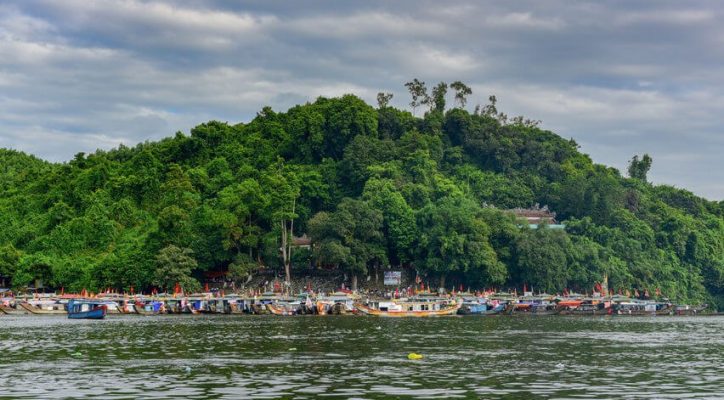
Hon Chen Palace is a relic cluster consisting of about 10 different large and small structures located in the middle of Ngoc Tran mountain, facing the Huong River, hidden under tall trees. The premises of the entire relic cluster are not very large, the main architectural work is Minh Kinh Dai located in the middle; on the right are the houses of Quan Cu, Trinh Cat Vien, and Thanh Pagoda; on the left is Ngu Hanh Palace, the altar of mandarins, caves of Mr. Ho and Ngoai Canh am. Near the bank of the river, there is also Thuy Phu am. In addition, within that area, there are many altars, many small houses scattered here.
Hon Chen Palace is not only a historical relic but also a scenic spot, a unique cultural attraction that attracts thousands of visitors, especially on the occasion of the festival in March and July of the lunar calendar every year.
Thien Mu Pagoda
Thien Mu Pagoda, also known as Linh Mu Pagoda, is an ancient pagoda located on Ha Khe Hill, on the left bank of the Huong River, about 5 km west of Hue city center (Vietnam). Thien Mu pagoda was officially founded in Tan Suu year (1601), the reign of Tien Nguyen Hoang – the first Nguyen Lord in Dang Trong.
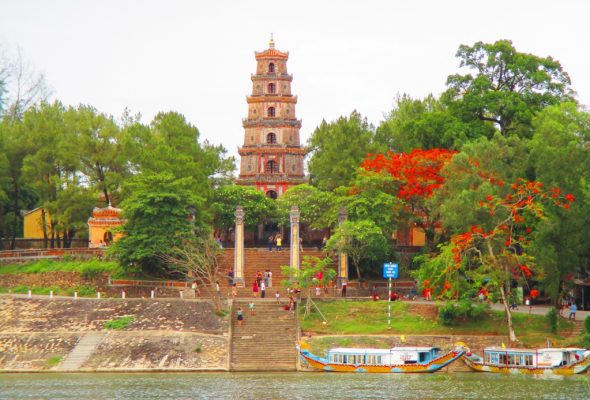
Legend has it that when Lord Nguyen Hoang came to be the retainer of Thuan Hoa and the governor of Quang Nam, he examined the terrain here to prepare for the plot to expand the business and build the mountain. While wandering the horse’s hooves along the Huong River upstream, he caught a small hill rising by the meandering blue water, so the ground was like a dragon looking back. This hill had the name Ha Khe hill.
Local people said that here at night, an old lady in red and green pants appeared on the hill, telling everyone: “Then there will be a true god who will come to set up a temple to gather spirit and make it durable lizard, for the mighty South country”. Therefore, this place is also called Thien Mu Son.
The great thought of Lord Nguyen Hoang seemed to be in tune with the will of the people. Nguyen Hoang was very happy, in 1601 built a temple on a hill, facing the Perfume River, and named it “Thien Mu”.
Tomb System in Hue
Tomb of Gia Long
Gia Long Mausoleum also known as Thien Tho Lang started to be built in 1814 and was completed in 1820. The tomb is a complex of many mausoleums in the royal family. This entire mausoleum is a group of mountains with 42 hills, large and small mountains, of which Dai Thien Tho is the largest mountain chosen as the predecessor of the mausoleum and is the name of the whole group.
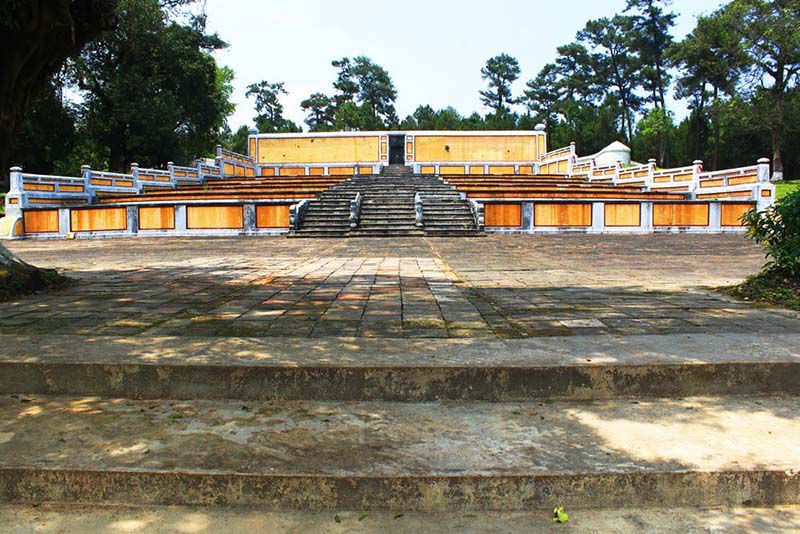
Minh Mang Tomb
Minh Mang mausoleum is also called Hieu mausoleum built by King Thieu Tri from 1840 to 1843 to bury his father Minh Mang. The mausoleum is located on Cam Khe mountain, near Bang Lang junction, which is the confluence of two streams Huu Trach and Ta Trach forming Huong River, 12 km far from Hue.
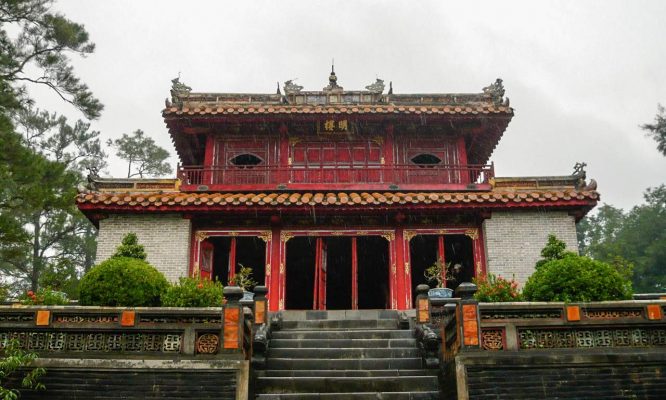
Mausoleum of Thieu Tri
Thieu Tri mausoleum, also known as Xuong Lang, is located in Cu Chanh village, Thuy Bang commune, Huong Thuy town. Built by King Tu Duc in 1847 to bury King Thieu Tri. Compared with the tombs of predecessors and successors, Thieu Tri’s tomb has its characteristics. This is the only mausoleum facing the Northwest, a direction rarely used in the architecture of palaces and tombs of the Nguyen Dynasty.
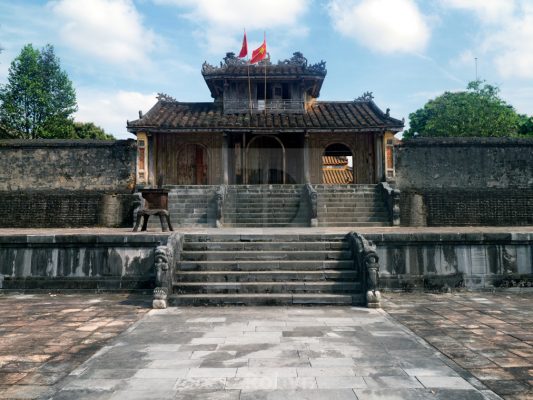
Tomb of Tu Duc
The tomb of Tu Duc was built by King Tu Duc himself when he was still in office, is a complex of architectural works, including the burial place of King Tu Duc located in a narrow valley of Duong Xuan Thuong village, Cu Chanh general, now it is Thuong Ba village, Thuy Xuan ward, Hue city. At the time of construction, the mausoleum was named Van Nien Co. After the Chay Voi rebellion, Tu Duc renamed it Khiem Cung. After Tu Duc’s death, the mausoleum was renamed Khiem Lang. The mausoleum has sophisticated architecture, charming landscape, and is one of the most beautiful tombs of the Nguyen Dynasty king.
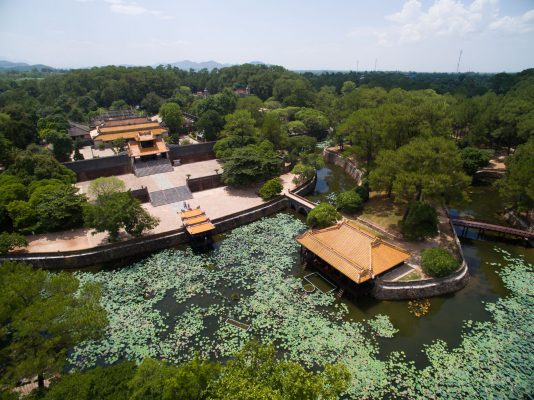
Tomb of Dong Khanh
Dong Khanh mausoleum, also known as Tu Lang, is located in the middle of the countryside of Cu Si village, Duong Xuan commune in the past (now Thuong Hai village, Thuy Xuan ward, Hue city). Formerly, Dien Truy Tu was built by King Dong Khanh to worship his father, Kien Thai Vuong. When Dong Khanh got sick and suddenly died. King Thanh Thai (1889-1907) succeeded in the context of the country facing many difficulties and a depleted economy, so he could not build a formal mausoleum for Dong Khanh.
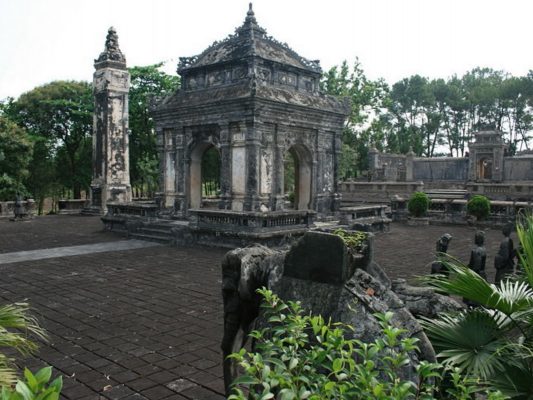
Tomb of Duc Duc
The Tomb of Duc Duc with the name of An Lang is located in Tay Nhat village, An Cuu village, formerly in Huong Thuy district, now in An Cuu ward, Hue city, less than 2 km from the city center; is the burial place of the three kings of the Nguyen Dynasty: Duc Duc, Thanh Thai, and Duy Tan. Duc Duc ascended to the throne in 1883 for 3 days when he was deposed and died. Later, his son, King Thanh Thai (ascended the throne in 1889), built a mausoleum to worship his father, named An Lang. In 1954, when King Thanh Thai died, the body was returned to the present site in the An Lang area and was worshiped at Long An temple. In 1987, the remains of King Duy Tan were buried next to Thanh Thai mausoleum.
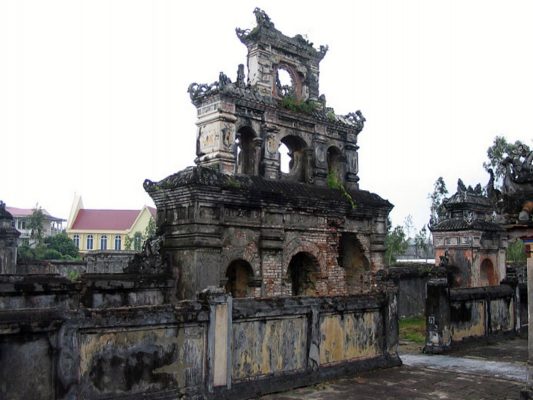
Khai Dinh Mausoleum
Khai Dinh’s mausoleum, also known as Ung Lang, is located on the slopes of Chau Chu mountain (also known as Chau E) outside the Hue capital city is the tomb of King Khai Dinh, the 12th king of the Nguyen dynasty. The mausoleum was built in 1920 right after Khai Dinh was crowned. About the architecture of Khai Dinh Mausoleum, later people often set out the traditional architecture of the Nguyen Dynasty because of the unusual mix of East-West and Kim Co architecture, with unique ceramic mosaic artworks.
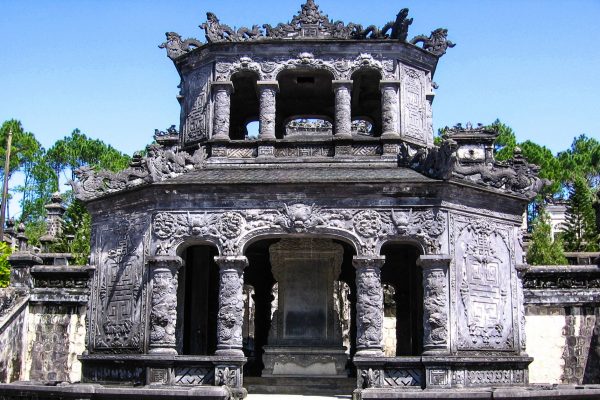
Tourist places in Hue City
Truong Tien Bridge
Truong Tien Bridge, also known as Trang Tien Bridge, is a 402.60 m long bridge, consisting of 6 spans of brow-shaped steel beams, with a span of 67 m each. The width of the bridge is 6m, designed according to Gothic architecture, spanning the Perfume River. The northern bridgehead belongs to Phu Hoa ward, the southern bridgehead belongs to Phu Hoi ward; right in the middle of Hue city.
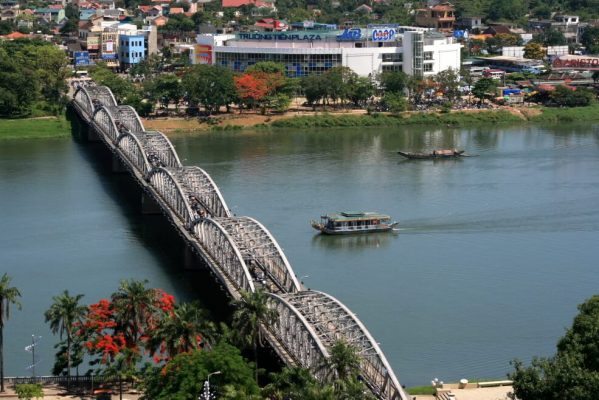
Huong River
The Perfume River has two sources. The Ta Trach source comes from the Truong Son mountain range flowing northwest through 55 majestic waterfalls, the Huu Trach source is shorter after crossing 14 dangerous waterfalls and reaching Bang Lang junction (Tuan confluence) merging with Ta Trach into the romantic Perfume River. The Huong River is 30km long (if only from Bang Lang to Thuan An estuary), the slope of the water flow is not much different from the sea surface, so the river water flows slowly. The watercolor of the Perfume River becomes greener when it crosses the foot of Ngoc Tran Mountain – Hon Chen Palace, creating a deep abyss.
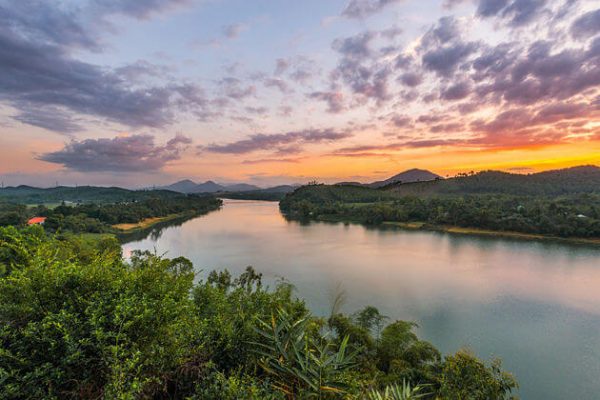
The Perfume River is beautiful from the source, meandering between mountains and forests, tree hills, bringing the aroma of tropical herbs. The river slowly passed through the green, tree-shaded villages of Kim Long, Nguyet Bieu, Vi Da, Dong Ba, Gia Hoi, Cho Dinh, Nam Pho, Bao Vinh, mingling with the scent of Hue flowers. The clear blue river shimmered like jade under the sun, the Hue boats swept up and down, along with the barbaric, thoughtful, deep melody in the middle of the night. Traveling by boat to see the poetic Huong Giang, listening to the dances and folk songs of Hue in the quiet night sky is the eternal joy of many classes of tourists,…
Ngu Binh Mountain
Ngu Binh Mountain (also known as Bang Son) is 105m high, majestic and balanced. The two sides of Bang Son have two small mountains called Ta Turn Son and Huu On Son. The Nguyen Dynasty, when building the imperial capital of Hue, chose this mountain as a precursor to a massive and solid defense system and renamed it Ngu Binh.
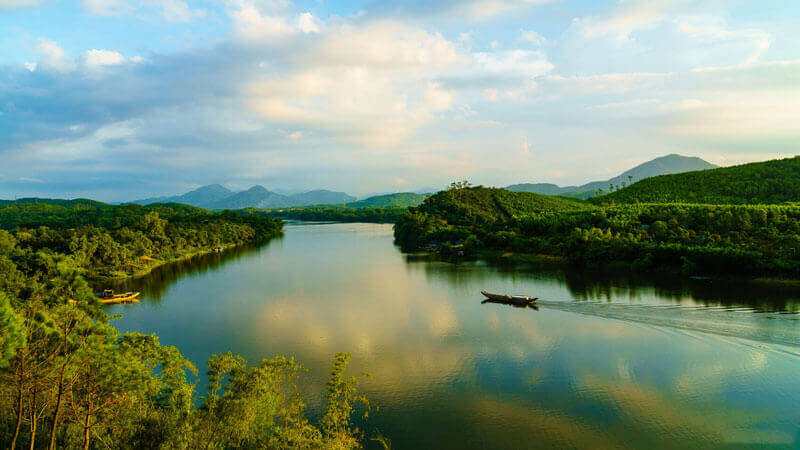
Along with the Perfume River, Ngu Binh Mountain is the second invaluable gift of nature, blending, to create the charming beauty of Hue. For a long time, this beautiful mountain together with the green Perfume River has become a symbol of Hue nature. People used to call Hue the land of Huong river – Ngu mountain, Huong Ngu region.
Dong Ba Market
Dong Ba Market is the largest market in Hue. The market is one of the symbols of the ancient capital, with a history of more than 100 years of construction and development. The market stretches from the foot of Truong Tien Bridge to Gia Hoi bridge with a total area of 47,614 m².
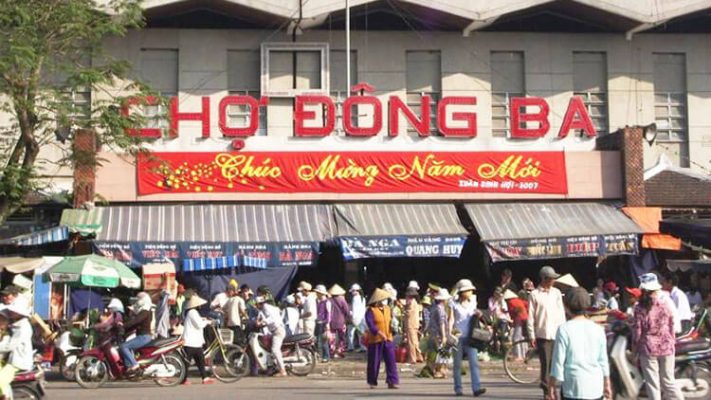
Hue Pedestrian Street
Opened at the end of September 2017, the pedestrian street of Hue includes Chu Van An, Pham Ngu Lao, Vo Thi Sau Streets and operates from 18:00 on 3 weekends. At this pedestrian street, you can enjoy a variety of Hue local dishes, watch street music performances or simply sip a drink with your friends.
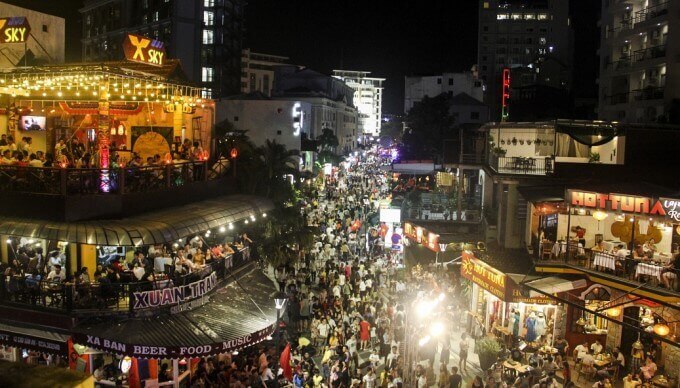
Hue Garden House
Hue is not only famous for its charming natural scenery but also especially attractive with the depth of cultural and spiritual beauty embedded in each architectural feature. Along with the mausoleum of thought. Ancient Imperial City, the peaceful and peaceful garden houses here make the “garden city” of Hue.
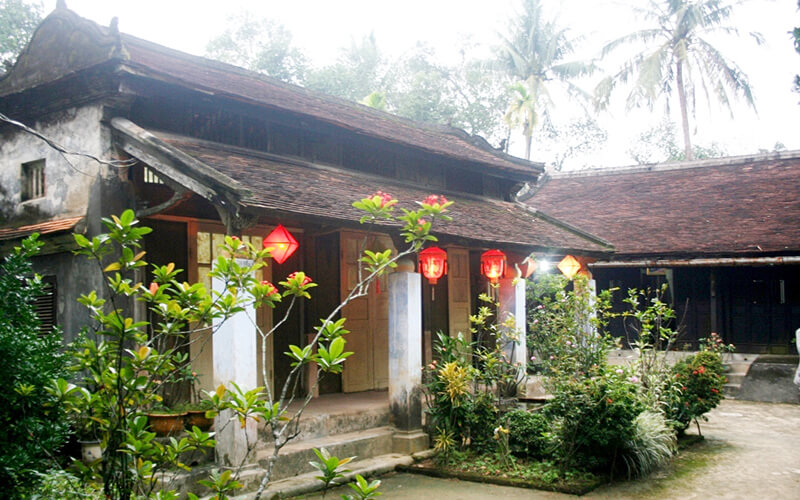
Built according to the law of “translation” and “feng shui”, Hue garden houses are a collection of an architectural system arranged in the North-South direction. Although the width is different, each house has the same overall architecture, including gate, lane, screen, rockery, shallow pool, yard, house. The gate is often built with bricks, the entrance to the alley is often planted with shady or carefully trimmed tea. The screens are also often built of bricks. After the screen was a shallow pool with rocky rocks, a large yard, and then came to the house. Around the house, there are a lot of trees and flowers all year round.
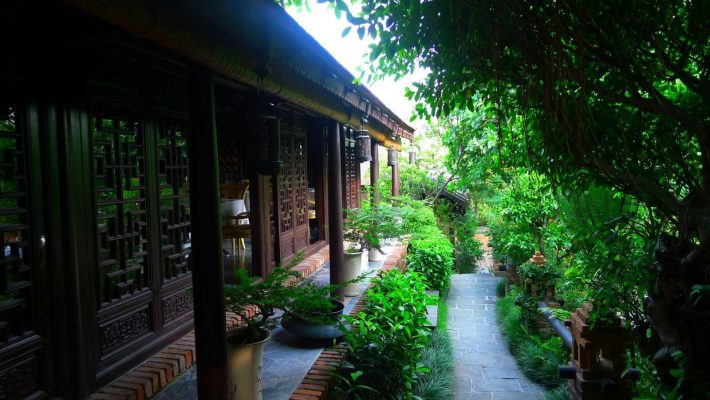
In that garden house, it is impossible not to mention the old temple house. The communal house is usually made of wood, they are elaborated with many carvings, in the linkage of the house structure, instead of crucifixion is a sophisticated dreaming technique. The communal house has many forms: one room with two wings, three rooms with two wings, five compartments and two lean-tos, a chest house,… a chest is a brief way of saying a pillar, a house with a system of wooden trusses built up according to the most specifications concentration. No matter how big, the school is also completely structured with pegs, wooden mortars for easy assembly and dismantling. The house is displayed in a collapsed mahogany, tea cabinet, hanging diaphragm, matching sentences, and furniture are arranged in harmony with each other, giving the communal house a separate spirit.
Looking at the landscape of a Hue garden house, one easily recognizes the owner’s soul and lifestyle. Hue garden houses show the harmony between human life and plants, spiritual and material life, all complement each other to create a balance in life.
Phu Cam Church
Phu Cam Cathedral is the cathedral of the Hue Archdiocese, located on Phuoc Qua hill, in Phuoc Vinh Ward, Hue city. This is one of the largest, most famous, and oldest churches in Hue. The church today is built in the style of modern architecture, designed by architect Ngo Viet Thu.
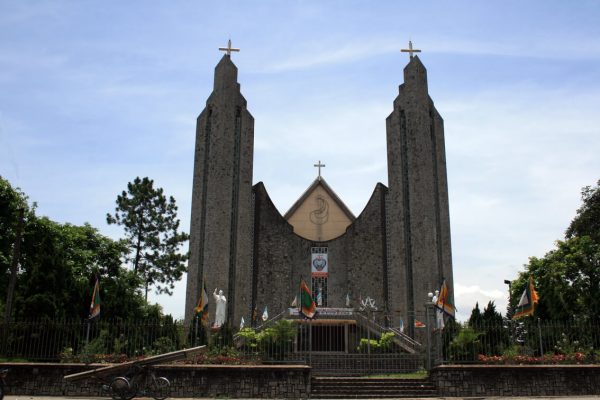
Architecturally, the church building ground is in the form of a cross, the tip towards the south, the north end. According to modern construction techniques, the church has a structure, but the decoration is still according to classical Western art. The supports are cast close to the wall, running gradually forward, soft. The four corners of each corner have three pillars extending outward, forming a large enough space to embrace the sanctuary and the altar.
The church’s heart is large, can accommodate 2,500 people attending the ceremony. There are two rows of colored mirror doors located in the upper part of the heart of the church providing light for the interior. The sanctuary is a circle with levels going up, to the top is a circle but smaller with a monolithic marble altar.
An Cuu River
An Cuu is the name of a small river, a tributary of the Perfume River, in the South of Hue Citadel. The river has many names such as Loi Nong, Phu Cam, Dai Giang, Ha Tu, and Cong Quan. The popular name in Hue is An Cuu River. The entire river is about 30km long, starting to take water from the Huong River from the end of Da Vien islet, flowing through Hue City, Huong Thuy district, and then pouring into Ha Trung Lagoon. Since the Nguyen lords chose Kim Long, and then Phu Xuan was the capital of Dang Trong, the two sides of the An Cuu river were the places of residence, garden houses of mandarins and aristocrats. However, at this time the river was still small, many sections were shallow and narrow. In Gia Long year 13 (1814), after surveying the situation and consulting the elders in Thanh Thuy commune, the king was allowed to open up the An Cuu River and build the Than Phu dam below to get water for irrigation pepper and saline washing for thousands of acres of fields in this area. In the 2nd Minh Mang year (1821), An Cuu River was renamed to Loi Nong River. The stele engraved with this name remains. In the 16th Minh Mang year (1835) when Cuu Dinh was cast, the image and name of the river were engraved in Chuong Dinh.
Beautiful temples in Hue
Tu Dam Pagoda
Tu Dam Pagoda is a famous ancient temple in Hue; Currently located at 1 Su Lieu Quan street, Truong An ward, Hue city. The pagoda was painted by Zen master Minh Hoang – Tu Dung around the end of the seventeenth century, and then named An Ton (or Tong) pagoda, which means “taking the transmission of the mind as the thread”.
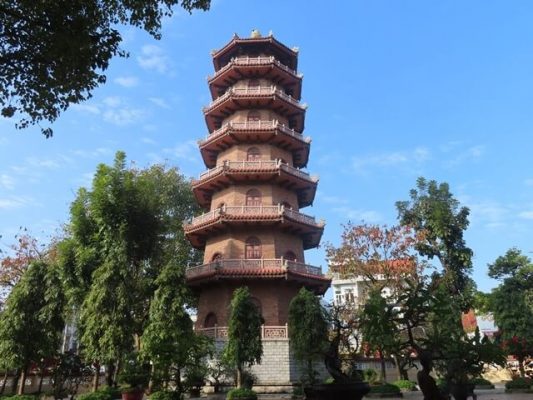
Tu Hieu Pagoda
Tu Hieu Pagoda or Tu Hieu Court is the name of a temple in Duong Xuan Thuong III village, Thuy Xuan ward, Hue city. The pagoda is one of the ancient temples and is a cultural and historical place of Hue’s ancient capital. Tu Hieu Pagoda is hidden in a pine forest in a hilly area of Thuy Xuan ward. The temple campus is about 8 acres wide, the front has a winding water slotting and a romantic landscape.
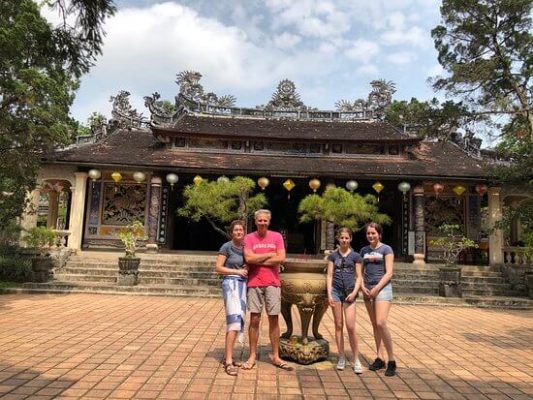
In front of the temple gate, there is a 3-story tower built in 1896 to be used as a place to store the spectacles according to the decree of the king. The gate of the pagoda was built in the style of a rolling arch, two floors with a roof, and right in front of the paved road to enter the main hall is a semi-circular lake with lotus planting and ornamental fish farming. The structure of the pagoda is in the style of three houses with two wings, the former is the Buddha shrine itself, the second is Quang Hieu Duong. In the back house, there is the worshiping ceremony of the capitalist Le Van Duyet with his wooden horse and sword.
The two sides of the temple courtyard have two steles to record the history of the temple’s construction. The pagoda was built in the form of a word (口), the main hall of three houses, two wings, in front of worshiping Buddha, and behind to worship the Patriarch. The backyard is Quang Hieu street, in the middle of the sanctuary, the left is to worship the Buddhist spirit at home, the right to worship the Thai bishops,… The left backyard is Ta Lac Thien (the monk’s house) and on the right is Huu Ai Nhat (guest house).
Tomb of Thai Giam of the Nguyen Dynasty in the temple grounds
Around Tu Hieu pagoda, there are also many tombs of concubines of Nguyen lords. Due to its beautiful and quiet location, not far from Hue city, this place is a place of outdoor entertainment for Hue youth on holidays and holidays. Tu Hieu Pagoda is one of the ancient temples welcoming domestic and foreign tourists, the largest in the ancient capital of Hue.
Bao Quoc Temple
Bao Quoc Pagoda is located on Ham Long hill on the old land called Thuy Loi village, close to Lich Doi hamlet. From here, looking down to the east is Dien Bien Phu Street (the road leading to Nam Giao flock), and looking north is the train station. The pagoda was founded by the Venerable Master Giac Phong, a native of Guangdong, China, in the late 17th century under the reign of King Le Du Tong and named Ham Long Tu. Then Vo Vuong Nguyen Phuc Khoat bestowed the quartet of Bao Quoc Tu in 1747. There are still gilded yellow plates and willows from that time. During the Tay Son period, the pagoda was used as a factory.
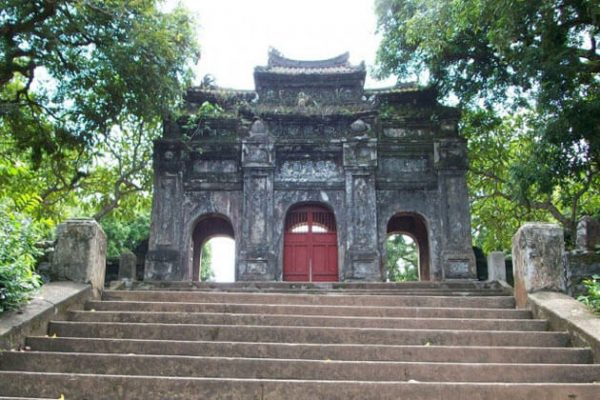
Thien Lam Pagoda
Thien Lam Pagoda was established in 1960 by Venerable Ho Nhan Nhan. Because in 1958, the Church nominated him from Tam Bao to the abbot of Tang Quang Pagoda; After a short time, he realized that the solitary practice of meditating, Tam y Nhat fetching his life by alms was not suitable here, so in 1960 he went to Thuong II village, Thuy Xuan commune, and built a small hermitage in Quang Te hill (now Thuong II Hamlet, Thuy Xuan Commune, Hue City) to practice.
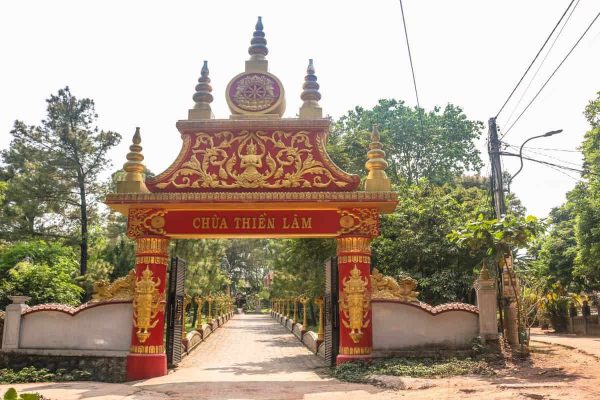
Thien Lam pagoda (also known as “Standing Buddha – Reclining Buddha”) was built in 1960 by monk Ho Nhan with its original shape just a small cup. Up to now, the pagoda is a complex of many architectural works such as statues, tomb towers, Buddha towers, monks’ houses,… in many different positions.’
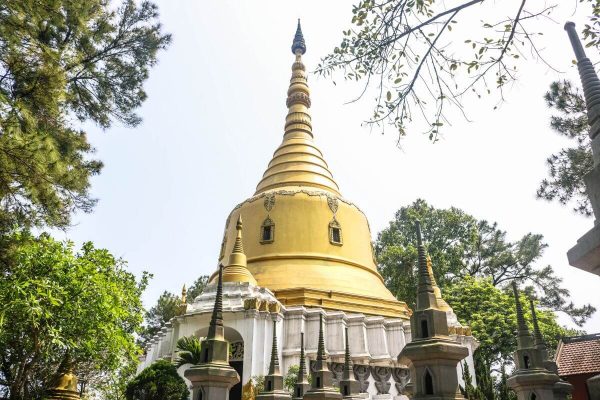
Different from any of the Buddhist temples of Tonkin with the three-door gate leading to the Zen garden, Thien Lam pagoda opens its door to welcome them with the Nam Tong Buddhist-style welcome gate, gentle but impressive. Entering the pagoda, at the end of the campus on the left is a tall, majestic and elegant white stupa in the sky. The stupa has 2 parts: the lower floor is the main hall; The upper floor adorns the relics of the Buddha Shakyamuni and the monks. It is a Buddhist temple in Nam Tong, but still clear in the space and architectural works of the temple. Not carrying on the thickness as the Bac Tong pagodas on the land of Hue, the pagoda “Standing Buddha – Reclining Buddha” evokes a feeling of “strange”, gentle and calm radiating from what the temple has.
Dieu De Temple
Dieu De Pagoda is located on the bank of Ho Thanh River, Hue people call it the Gia Hoi river, or Dong Ba river, now 100B Bach Dang street, near Gia Hoi bridge. Dieu De Pagoda has an important place in the history of Buddhism in Hue. The pagoda was originally the residence of King Thieu Tri before taking the throne, so it had a very beautiful landscape, spacious garden, and green trees. In 1844 the king was embellished and ordained as the National Self. The pagoda has become a famous place on the land.
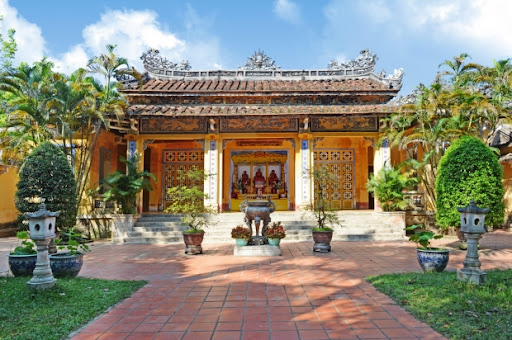
Vong Canh Hill
Vong Canh Hill is a 43m high hill in the southwest of Hue city, the foothill bordering the Perfume river. It is located in the mausoleum of the Nguyen kings and opposite the Hon Chen palace established in ancient times by the opposing faction. Around seven hundred meters from Vong Canh hill are Dong Khanh mausoleum, Tu Duc mausoleum, Thieu Tri Mausoleum, Hieu Dong mausoleum (Minh Mang King Wife), Xuong Tho mausoleum (Tu Du’s wife, Thieu Tri’s wife). Tomb of Madame Thanh Cung (wife of King Dong Khanh), Tomb of Mrs. Tu Cung (wife of King Khai Dinh), Tomb of Prince Canh (son of King Gia Long),…
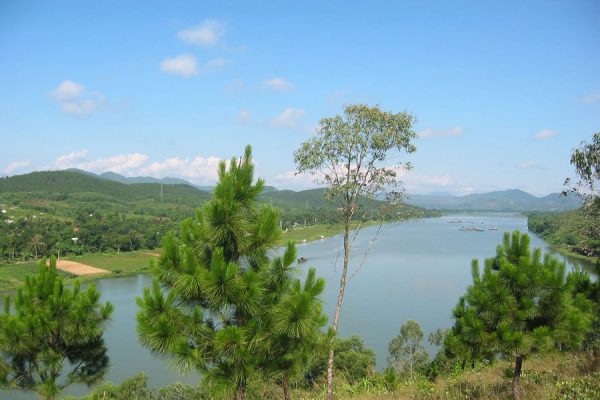
Standing on Vong Canh Hill, one has a panoramic view of many ancient relics and wonderful scenes in a large natural space around, especially the poetic beauty of lyrical. Huong river. The hill sits in the middle of the softest, most tender, and attractive bend of this famous, amorous, and sexy river. This is where rivers and mountains come together to create a magnificent painting space. The meaning of the place Vong Canh is like that.
Phong Dien
Thanh Tan Mineral Spring
Discovered in 1928 by French scientists, Thanh Tan mineral spring was quickly researched and applied as a beverage to restore human health. In 1983, this water source was allowed by the Ministry of Health to be exploited as bottled drinking water. However, by the end of 2000, Thanh Tan mineral spring tourist resort became popular and known to many people. Thanh Tan mineral spring tourist area built on an area of 50 hectares. Next to the towering mountains are the adjacent created hills. The green of the mountains and trees has created a relaxing and pleasant feeling from the first minute. Thanh Tan mineral water is located thousands of meters underground, containing Calcium Sulfate and Silicium,… very good for the body. Therefore, this is a suitable destination for many tourists in the chilly weather, changing seasons.
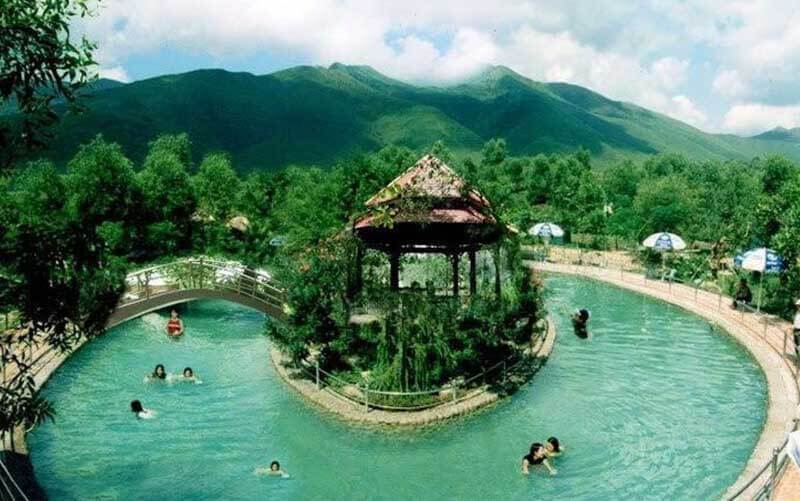
Thanh Tan mineral water tourist area also has a spacious playground for campfire or entertainment at night. After many hours of a soaking, hungry stomach, you will be more delicious with a plate of perch raised with mineral water, deep-fried in lovely tents beside a fragrant lotus lake.
Phuoc Tich Ancient Village
Phuoc Tich ancient village is located on the border between Thua Thien Hue and Quang Tri provinces. According to history books, Phuoc Tich was founded in 1470 under Le Thanh Tong and is surrounded almost entirely by the legendary O Lau river, the river’s water is always blue, making this place almost an island. More than 500 years of existence, experiencing wars of fire and destruction of nature. Phuoc Tich still preserves almost intact the pristine beauty of Vietnamese village life with charming and peaceful landscapes, banyan trees, water wharf, communal yard.
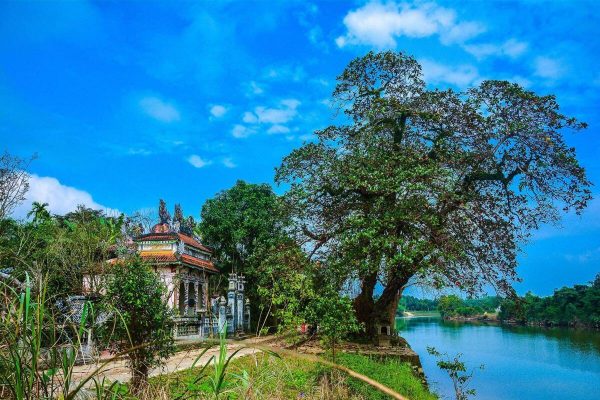
Tam Giang Lagoon
Tam Giang is the confluence of three rivers O Lau, Bo River, and Huong River before pouring into the East Sea. Therefore, Tam Giang lagoon is “symbolic” of the ecological environment of Thua Thien – Hue in the past and present. Not a single tourist comes here, to ignore this famous place.
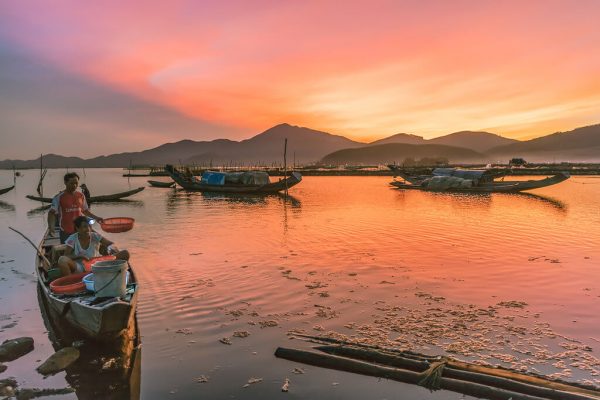
This is the largest wetland in Southeast Asia, the water surface is 248.7 km2 wide, from the mouth of the O Lau River in the north to the mouth of the Huong River in the south. The lagoon has had many aquatic animals for many generations, most of them in Thuan An estuary, O Lau river mouth, Bo river, Thuy Tu lagoon. Cau Hai. At present, there are 163 fish species, many rare and precious species such as sea bass and eel have been identified. Depending on the season, some fish species migrate into the lagoon to breed such as sardines, sea anchovies,… In contrast, mullet, grouper, and rabbitfish living in the lagoon migrate to the sea to spawn. All year round, fishermen catch on the lagoon about 23 species of fish with high economic value, including thick fish, goby fish, goby fish, barramundi, snapper, fish,…
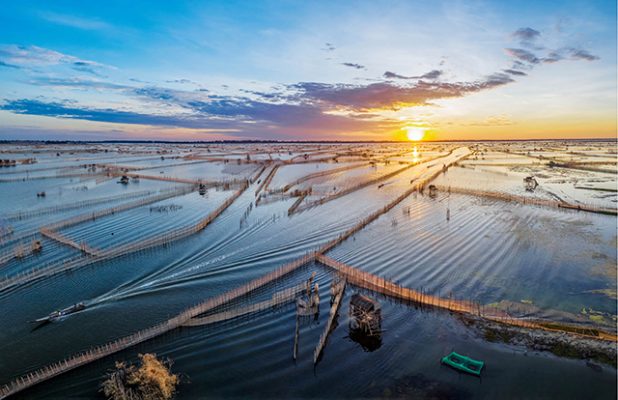
The surface of the lagoon has natural vegetation, so water birds gather here, forming large bird sanctuaries at O Lau estuary, Dai Giang river mouth, and Sam lagoon. Through monitoring, 34 migratory bird species, 36 settlement bird species, especially 21 bird species are on the list of strictly protected European communities and one species listed in the Vietnam Red Book.
The lagoon facing the East Sea stretches for more than 68 km, separated from the sea only by a narrow strip of sand, through the two estuaries of Thuan An and Tu Hien. Therefore, it can self-clean the water environment and is always rushed inside by the East Sea waves, becoming a large “lung” to regulate the ecological environment for the entire Thua Thien Hue province naturally and regularly.
Phu Vang
Dam Thuy Tu
Thuy Tu lagoon is one of three lagoons that make up the Tam Giang lagoon. Thuy Tu lagoon includes An Truyen lagoon, Thanh Lam (Sam), Ha Trung, and Thuy Tu. Thuy Tu lagoon stretches from Thuan An bridge to Con Trai over a length of 33km. The lagoon width varies from 0.5km (Thuy Tu lagoon) to 5.5km (An Truyen lagoon), on average 1.8km, the lagoon depth varies from 1 – 1.5m to 3 – 5m depending on the area. but the most common is 1.5 – 2m. The water surface area of the lagoon is up to 60km. This is a place with many beautiful scenes and famous products.
Dam Chuon is part of the system of Dam Thuy Tu. In particular, the nature of the Chuon lagoon is more wonderful in the early morning and the afternoon with colorful colors.
Dragonfly Lagoon
Dam Chuon in Phu Vang district covers an area of more than 100 hectares, located nearly 15 kilometers east of Hue city center. This is a part of the Tam Giang lagoon system with a fresh and peaceful atmosphere.
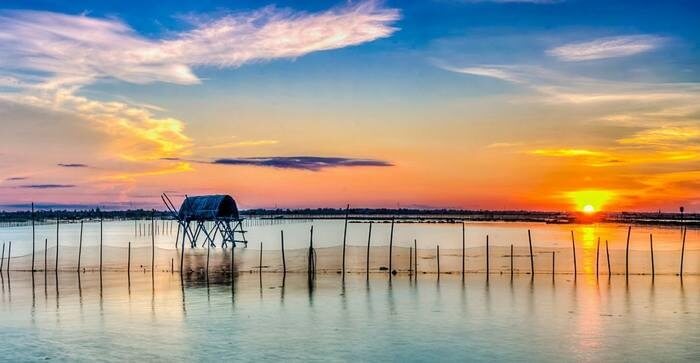
Thuan An Beach
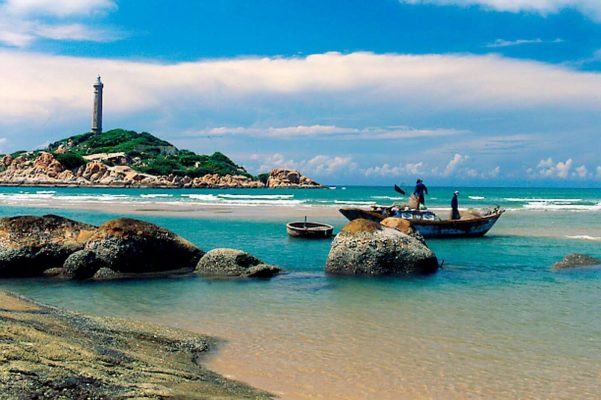
Huong Thuy
Tile Bridge Thanh Toan
Thanh Toan tile bridge is a wooden arch bridge with a tile roof over a ditch of Thanh Thuy Chanh village, in Thuy Thanh commune, Huong Thuy Town, Thua Thien – Hue province, about 8 km southeast of Hue city. This is a wooden bridge that is classified as rare and has the highest artistic value among ancient bridges in Vietnam.
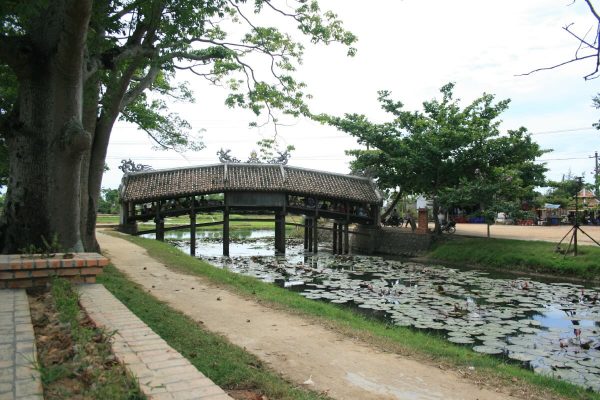
The Thanh Toan tile bridge is built in the way of “the upper house and the overseas” (above the house, under the bridge). The bridge is 43 meters long (18.75 meters), 14 meters wide (5.82 meters), divided into 7 sections, the two sides of the bridge have two rows of wooden platforms and balustrades for sitting back. The bridge is covered with a roof and tile. The first bridge built more than two centuries ago has been repeatedly damaged by storms, floods, and wars. However, after the damaged times, the commune people all repair, embellish and preserve them together.
Thien An Hill – Lake Thuy Tien
Thien An is a place of many pine-growing hills southwest of Hue city, near the tomb of King Khai Dinh. On the top of the hill, there is Thien An Monastery, around the hill area, there is Thuy Tien lake and Ba Vanh tomb, still imprinted with an old suspect. With peaceful scenery, fresh space, Thien An and Thuy Tien are quite interesting weekend getaways. Currently, this area is the entertainment center of Thua Thien Hue.
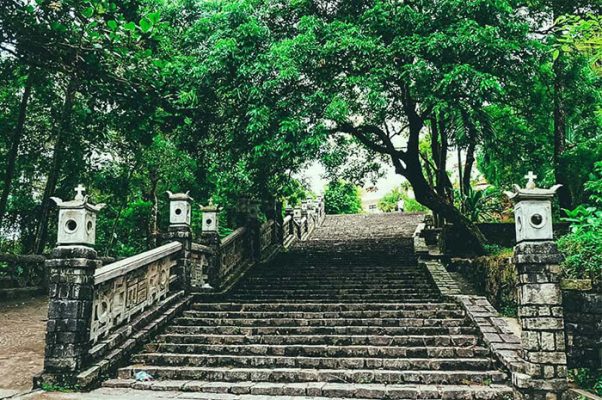
“Dăm” Stone Waterfall
“Dăm” Stone Waterfall is a small waterfall in Duong Hoa, Huong Thuy town. You can organize with family and friends to come here to have fun, take a cool bath on holidays. From the center of Hue city, there are two roads to the waterfall: one is along the road through the Ta Trach lake project; the second is going in the direction of Tuan Bridge, passing Tan Ba pier. Starting in the direction of Week Bridge, we will easily buy fresh food or some local agricultural products at the countryside market. Meet the bar during tea season, do not forget to visit some roadside orchards, enjoy the scenery while buying this specialty to bring refreshments.
The road to the waterfall is quite unspoiled, so it is very suitable for those who love adventure by motorbike, especially young people. Want to conquer the height, catch the watershed, be very prepared to not slip when walking along the cliffs; You can also have fun in the cool lake below the waterfall. The romantic one goes to pick wildflowers, look for ripe sim,… On the way to the waterfall, there is a small house of Forest Ranger Huong Thuy. The staff members will be the “locals” that provide much useful information about the people and creatures of this area. If you have difficulty in walking, looking for water,… do not hesitate to ask for help.
Huyen Khong Son Thuong
Huyen Khong Son Thuong, located in Cham village, Huong Ho ward, is a famous pagoda, a scenic spot of the ancient capital of Hue. The pagoda belongs to the Theravada Buddhist sect, was founded by Venerable Gioi Duc in 1989. The temple is located in the middle of a green, cool, year-round pine forest, birds chirping. Huyen Khong Son Thuong is located halfway up the mountain with a strange and fanciful beauty. The pagoda does not have a large Tam Quan gate, but the gate is just as ordinary as the gate of a Hue garden house. The temple campus is a green garden with small streams blooming with purple water lilies, precious orchids, porcelain trees, cedars, cypresses,… hundreds of years old, peaceful space.
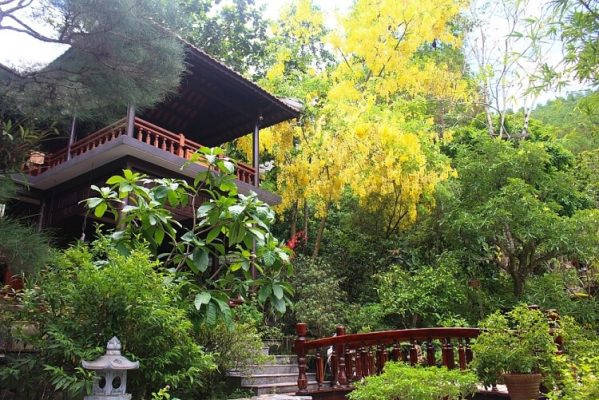
Phu Loc
Ho Truoi
Truoi Lake with an area of about 400 hectares, a reservoir capacity of up to 60 million cubic meters of water, is the largest irrigation project in Thua Thien – Hue province, to irrigate the fields of Loc Hoa and Loc Dien communes. Phu Loc district. Previously, the area of the lake was a very small Truoi dam to prevent water 50 meters high was built by Thua Thien – Hue province in 1996.
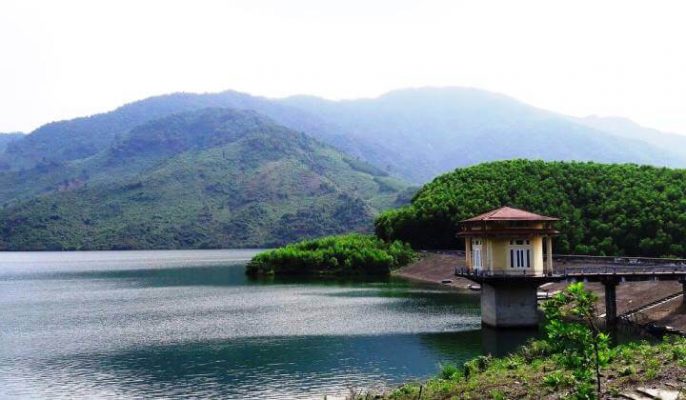
Truoi Lake tourist area is located at the foot of the majestic Bach Ma Range. Coming to Truoi Lake, visitors will see clear blue water surrounded by green mountains, charming landscapes.
Truc Lam Bach Ma Zen Monastery
Belonging to the Truc Lam Yen Tu Zen sect, Truc Lam Bach Ma is the first Zen monastery in the Central region, located at Bach Ma mountain, Truoi lake area, Loc Hoa commune, Phu Loc district, Thua Thien Hue province. At the height of 1450m, the temperature is usually from 19-21 oC, Bach Ma is considered one of the ideal climates. Truc Lam Bach Ma Monastery appeared in the heart of Truoi Lake like a flower, resting its head on the mountain of Bach Ma forest stretching to attract the eyes.
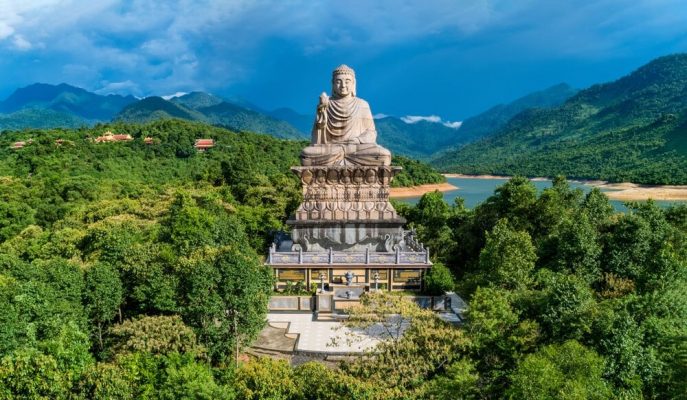
About 30 km from Hue city to the South, to Truoi land, go to Truoi Dam, cross the steep slope on the back of the hill, and a vivid water-ink picture appears. On the other side of the water, at the foot of the sacred mountain, the pavilion, the main hall, the road, the road, the staff, the bell floor, the relic tower shines down on the water mirror of Truoi lake, far away are clouds swirling around The top of the mountain creates a fantastical, pure and peaceful space.
Passing the immense river bed of Truoi lake, about fifty minutes, by small canoes, you will arrive at Truc Lam Bach Ma Monastery. Step up from the 172 steps of the three steps are the three relics of Truc Lam Bach Ma Zen Monastery. Built-in harmony in a whole body of Buddhist architecture and Truc Lam Yen Tu Zen Monastery, Truc Lam Bach Ma also has the very shrine of Buddha sitting under the bodhi tree, behind the main hall is the area. The street is dedicated to the ancestor Dat Ma of the Truc Lam sect. Truc Lam Bach Ma Zen Monastery is a scenic complex in the charming mountainous area that has become a tourist destination for tourists coming to Hue.
Bach Ma National Park
Bach Ma National Park, 60km south of Hue, at an altitude of 1,450m, is a famous resort in Vietnam. On the top of a majestic mountain in 4 green seasons with waterfalls, forest streams, is a temperate climate like SaPa, Tam Dao, Da Lat,… Bach Ma mountain is also a gathering place for many kinds of precious animals and plants. rare in the tropics.
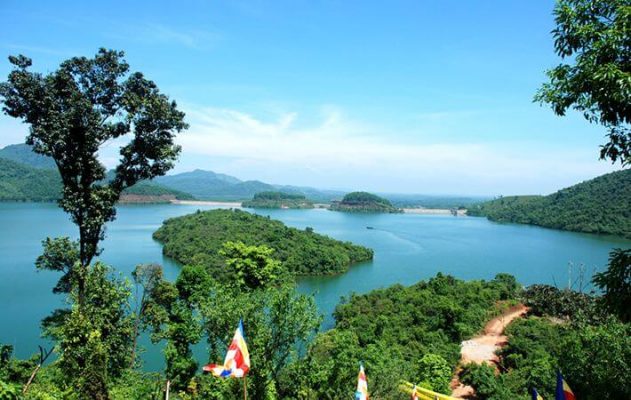
Bach Ma Mountain is famous for its streams and many spectacular waterfalls. Do Quyen waterfall is 400m high, 20m wide. On summer days, on both sides of the waterfall, Do Quyen flowers bloom like two giant carpets of silk flowers. In the center of the resort, there is a Silver waterfall 10m high, 40m wide like a white curtain swaying in the wind.
Standing on the top of Bach Ma mountain, you can get a glimpse of the splendid panoramic view of Hai Van Pass, Tuy Van Mountain, Cau Hai Lagoon, and the shimmering electricity of Hue city at night.
Canh Duong Beach
Canh Duong is one of the beautiful beaches in Thua Thien Hue, about 60 km south of Hue city. Canh Duong beach is 8 km long, 200 m wide, arc-shaped, between the foot of May Tay and the foot of May Dong, the coast has a gentle slope, smooth white sand, clear blue seawater, and relatively windtight. conducive to the organization of various types of tourism and sports.
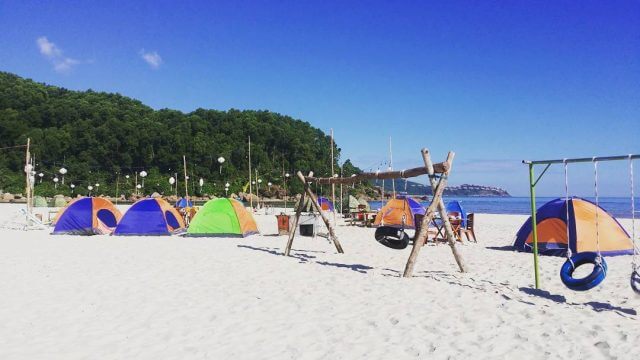
Lang Co
Lang Co beach is about 8km long, located along National Highway 1A, next to Hai Van pass and 24km from Bach Ma National Park. This is a beach with a gentle coastline, white sand, medium and large waves, the tide rises and falls according to the semi-diurnal tidal regime with a low difference (only about 0.7-0.8m), very suitable for this type. tourism image of swimming, relaxation, scuba diving, and has been identified as an ideal resort for decades. Located adjacent to Lang Co beach is Hai Van mountain – Hai Van Quan, a famous landscape of Vietnam. Along the foothills of Hai Van mountain, Lang Co beach has coral reefs, lobsters, and much high-value seafood. In that area, there is Son Cha Island (a small island), which preserves many kinds of wild fauna and flora.
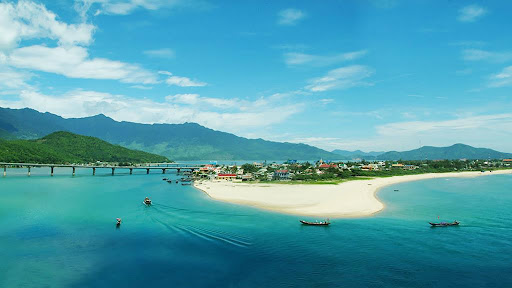
Behind the beach is Lap An lagoon and Bach Ma mountain range. All of these factors give Lang Co great potential for developing many types of tourism services: resort, scuba diving, wildlife – flora and fauna, aquaculture,…
Dam Lap An
Lap An lagoon (An Cu lagoon) is located near the National Highway 1A, the section passing Lang Co town, Phu Loc district on the road connecting Da Nang to Hue. The lagoon is located in a quiet beautiful position at the foot of Phu Gia pass with a radius of 15 km2. Surrounding the lagoon is the majestic Bach Ma mountain range, in front of the lagoon is Lang Co Bay.
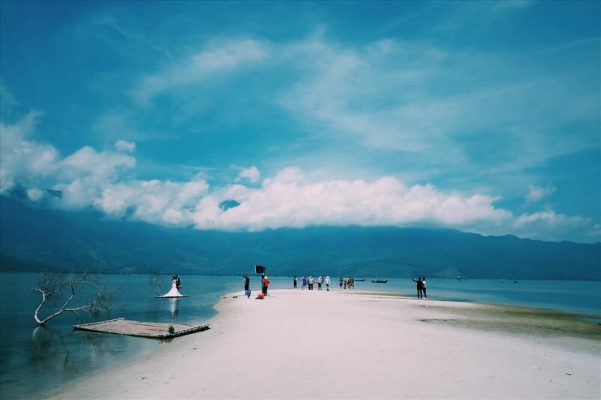
Cau Hai Lagoon
Cau Hai lagoon is the largest lagoon in the lagoon system of Tam Giang, with a circumference of more than 100km, located in the South – in the territory of Phu Loc district, Thua Thien Hue. To get here, you can go two ways: one is from the intersection of Phu Bai airport, follow Phu Bai – Truong Ha street towards the sea, meet NH 49B, turn right about 30km, is Tu Hien gate, that’s where capture the most beautiful Cau Hai lagoon, or follow National Highway 1A from Hue to Da Nang, to Cau Hai station area will see immediately on the left is Cau Hai lagoon. About 8km more, you will meet NH 49B again to turn left to the Tu Hien entrance.
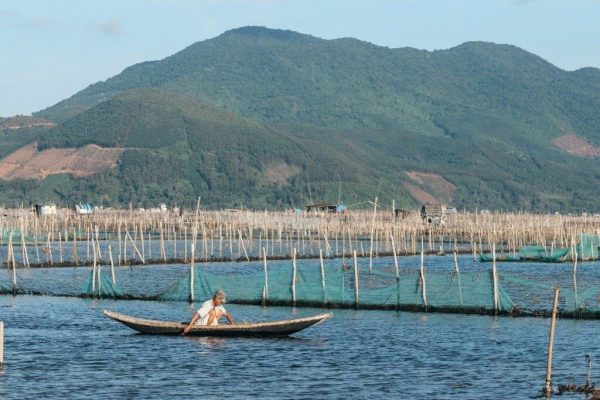
Suối Mơ
Suoi Mo or many people still call Mo waterfall is an interesting tourist destination located in Lang Co town, Phu Loc district, about 65km from Hue city. Suoi Mo welcomes visitors with a king fresh and cool primeval forest. This is an interesting place for families who want to escape the central sun during hot days.
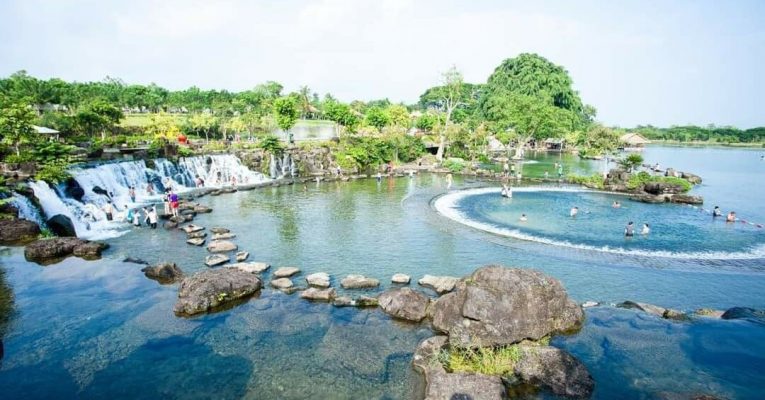
Hai Van Quan
In the past, Hai Van Quan was a key strategic location of Thuan Hoa – Phu Xuan – Hue in terms of military and road traffic, which was the southern gate of this land. Hai Van Quan is located at the top of a pass over a mountain range that runs across the sea from the Truong Son range. The top of Hai Van pass is 496m above sea level; 77.3km south of Hue and 28.7km north of Da Nang.
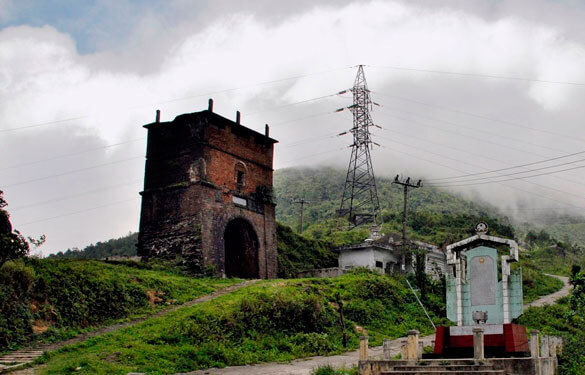
In the first “Du Chi” of our country compiled by Nguyen Trai in 1435, the author mentioned the place “Ai Van”, as a weakness on the road from Thuan Hoa to Quang Nam. And now, together with Lang Co – Bach Ma – Canh Duong, Hai Van Quan is attracting domestic and foreign tourists to visit and enjoy the majestic beauty of mountains and sea.
Nam Dong
Mo Waterfall
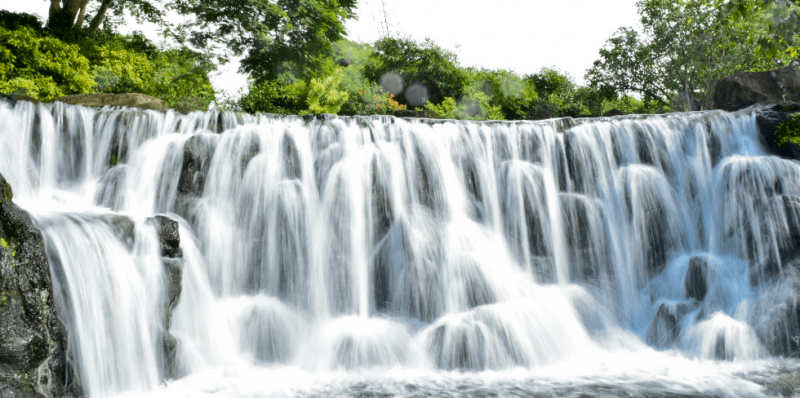
Kazan Falls
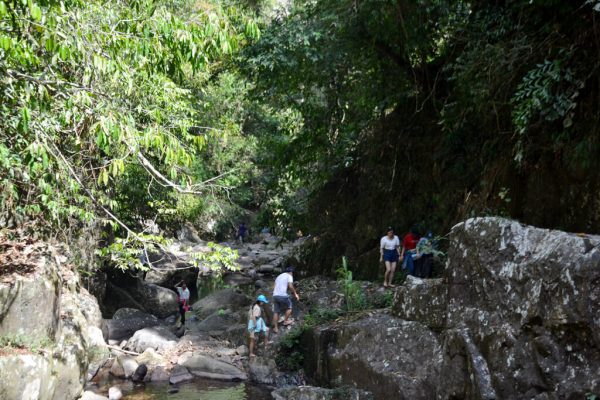
A Luoi
A Nor
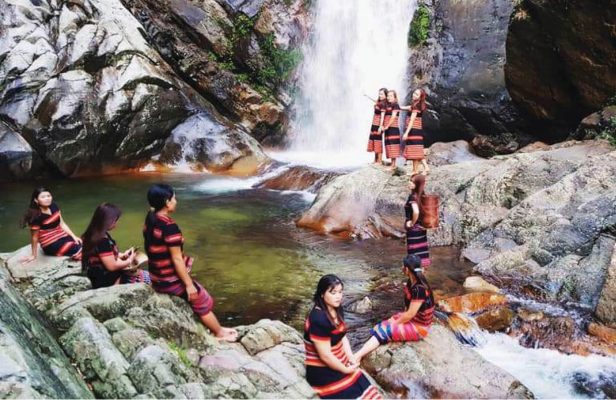
Pâr Le Stream
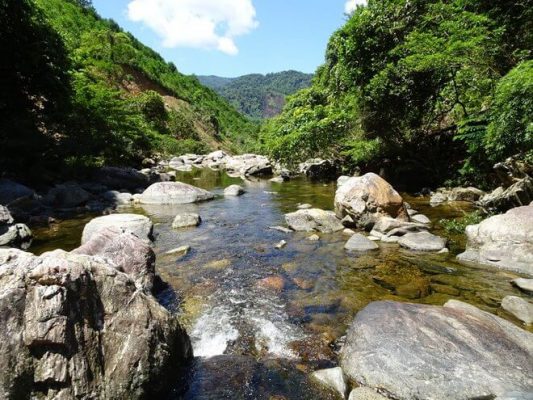
Vietnam-Laos Border Landmark
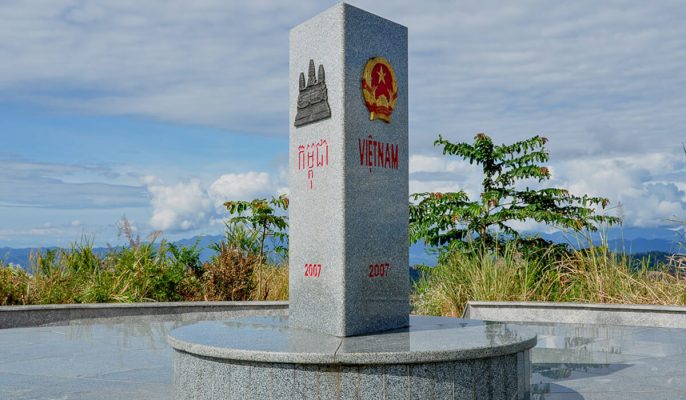
Delicious dishes in Hue
It can be said that Hue people come to cuisine, not in a simple biological sense, but to enjoy it with both smell, sight, and hearing. Speaking as writer Nguyen Tuan when he was born, Hue people like to eat with their eyes. But even though they mobilize all their senses for nutrient absorption, the Hue people only need to “eat the fragrance for flowers”, as they often talk about themselves. That serenity can be seen on the tiny duck cake that is almost melting at the tip of the tongue, the thin rice cake leaves, the Nam Pho cake bowl arranged like colorful pictures and Con Hen corn tea. cool, but the aroma follows the dream,… Hue dishes, whether it is a delicacy or a simple folk, make someone taste so delicious once they “suck it up”, to and then forever attached to that unforgettable taste. It seems that through the skillful hands of the woman, the food has been blown into Hue’s soul and a little spirituality.
Hue especially preserves more than 1000 dishes cooked in the Hue style, including the benevolent dishes of the Nguyen Dynasty kings. The menu of dwellers has over a few dozen dishes of the delicacy of delicacy, which are carefully prepared and organized. The folk dishes are very popular among the masses with a rich menu of hundreds of dishes, cleverly prepared by Hue housewives with excellent cooking techniques, attractive flavors, and attractive colors, attaching importance to quality over quality; the art of presenting the dishes is very beautiful, the art of enjoying is exquisite. In addition, if anyone has ever enjoyed a Hue vegetarian meal (dishes made from plants), surely will never forget the pure taste of Hue dishes.
Cơm Hến
Rice with mussels is a specialty of Hue cuisine. Rice with mussel is presented in the form of cold rice mixed with mussels sauteed in oil and spices, mussel sauce, fish sauce, cabbage, greasy, grilled rice paper, crispy fried noodles, colored chili, whole-grain peanuts, cooked cooking oil, pepper, refined flavors (monosodium glutamate, MSG) and salt.
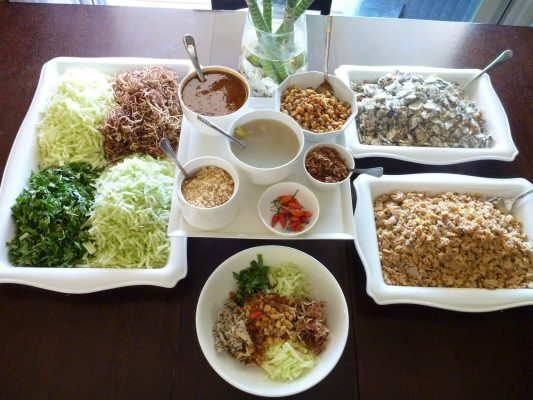
The mussel rice dish originated as a familiar dish of the people of the fishing village,… from the locality, it was called the sampan people. They live all year round on boats, floating on the river branches with low income, not much income. Fishing nets that can be found in the river like shrimp and fish,… are high-end food, often sold, while inexpensive mid-range like snails, mussels,… make the most of daily meals. Clams are almost always treatable. If you want to eat delicious mussel rice, you can go to Han Mac Tu street or to Con Hen, Vi Da to enjoy.
Bun Bo Hue
Bun Bo Hue is one of the specialties of Hue, although it is available everywhere. In Hue, this dish is simply called “beef noodle soup”. Other localities called “Hue beef vermicelli” indicate the origin of this dish. The main ingredients of the dish are vermicelli, beef, pork, and a distinctive red broth. In the broth of vermicelli, Hue people often add a little fish sauce, contributing to the unique flavor of Hue beef vermicelli pot. After the beef bone is cooked until cooked, people often add little pork pies or pureed beef rolls. Beef can be thinly sliced, dipped in boiling broth before being placed in a bowl of vermicelli (called raw beef). People often add a little chili powder and spices to the bowl of vermicelli and eat raw vegetables including bean sprouts, herbs, lettuce, baby vegetables, chopped banana corn.
Noodles are not available anywhere, but the appearance of the bun is different in each region. Hue noodles are bigger than other places. There are two types of vermicelli, the vermicelli is usually rolled into small cubes when hungry, but dipping it with garlic lemon chili sauce is great. And the vermicelli used to make pork rolls or crab vermicelli is usually larger.
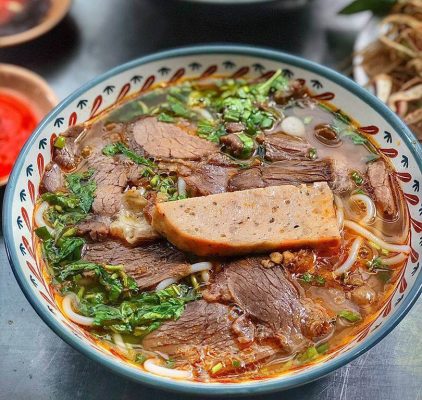
Along the two sides of the road in Hue, you will immediately meet the very popular but also very delicious noodles, very crowded,… A bowl of vermicelli or vermicelli that attracts customers is thanks to the sweet and fragrant water. The vermicelli pot, a very thin flexible aluminum pot and very cleverly milled by Hue matters, looks like an old copper pot but has a deep and wide mouth. The pot is scrubbed very carefully so it is always bright white and looks very good on the eyes. Eat a bowl of steaming vermicelli, the clear white strands that stand out on it are pink-grown balls (pellets from raw rolls and crab meat), softly simmered hooves, with a hint of white stalks. The price and the green color of raw vegetables, take a little rich fat leopard juice with a little seasoning of the lemon chili fish sauce, you will find it extremely interesting, both spicy, hot, pungent, and hear the sweetness of the vermicelli juice. Of meat running slowly into the esophagus, you will certainly not forget this flavor. There was a time when eating vermicelli brought me to tears at that time to feel how deep the taste of Hue was.
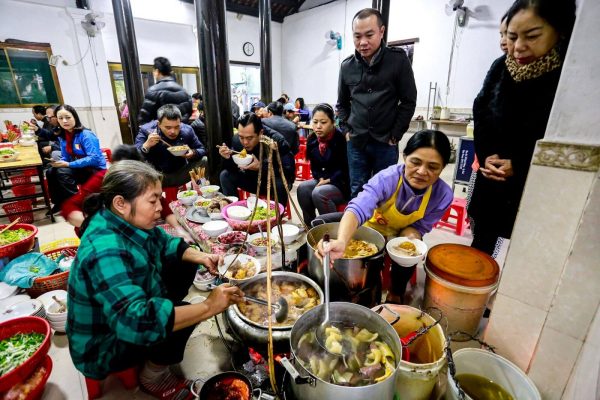
Besides the shops, fixed shops on almost all the streets of Hue city, every morning you walk the streets of Hue you will see Hue girls about eighteen and twenty, shoulder to shoulder. One bun went in groups, the smoke floated away, laughing happily. That was a Hue girl selling vermicelli to customers all over the city. Each person has each look and each flavor, but all Hue and Hue are from vermicelli, from aluminum pots, from fast and smooth gait, and no matter how difficult you are, you will be satisfied when Enjoy a very popular noodle bowl, very cheap, but sometimes very delicious.
If you want to enjoy authentic Hue beef noodles, you should go to the area of Chi Lang Street intersecting with Nguyen Du. There are some famous beef noodle shops here such as O Lieu beef noodle soup, Mu Drop beef noodle soup, Ba Phung beef noodle soup,…
The Typical Cakes of Hue
Banh Beo
The Banh Beo consists of three main parts: the cake made from rice flour, the filling to sprinkle on the cake made with pureed shrimp, and the sauce, a mixture where fish sauce is the main ingredient and often poured directly into the cake without dipping. . The auxiliary ingredients of the Banh Beo are usually onion fat, crushed roasted peanuts. Depending on the locality, there are different ways to add or remove this cake, for example, in Saigon, they often leave green beans, sour food, and serve them with molded cakes, small cakes, and filtered flour cakes.
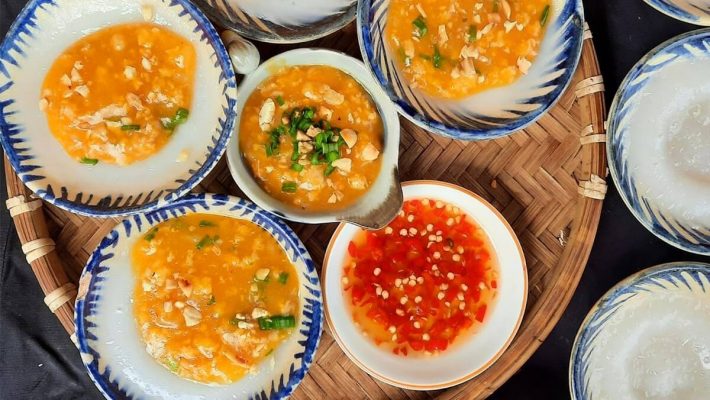
In the Central region, Banh Beo is often divided into two types: Quang Nam Banh Beo and Hue Banh Beo. Quang Nam water fern cake is usually big, thick, served with a paste made of dough including meat, minced shrimp, chives, when eaten with a little scallion, minced chili. Hue Banh Beo is a little different, the cake is thinner, has dried shrimp powder, when eaten with crispy pork skin.
Banh Bot Loc
Tapioca cake is a type of cake from tapioca, filtered for starch, then boiled a small amount of flour, stuffed thoroughly, and made cakes. The filling is usually made of shrimp mixed with spices, can be made with lean pork, or a mixture of shrimp – pork. After being squeezed into the cake, the cake is wrapped in banana leaves (or may not be wrapped) and steamed. This is a popular dish in the North Central provinces and especially Hue.
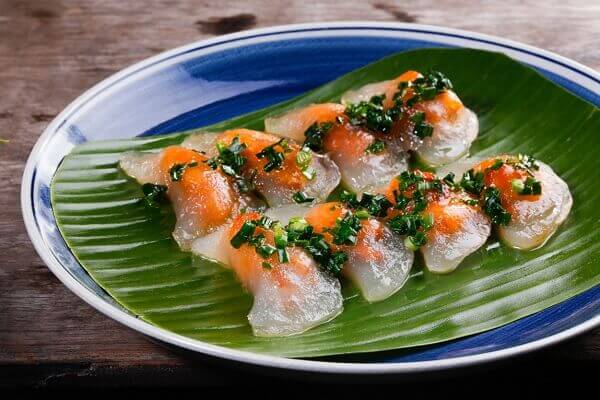
Banh Nam
Banh Nam is a type of cake and typical traditional cuisine of Hue, along with Banh Beo, banh mi. This is a cake made from rice flour that is both delicious and healthy (the elderly, children, and sick people can eat it). full moon day, the first day. In particular, there are rice cakes filled with toad meat, for stunted and malnourished children, as delicious and attractive as shrimp cakes.
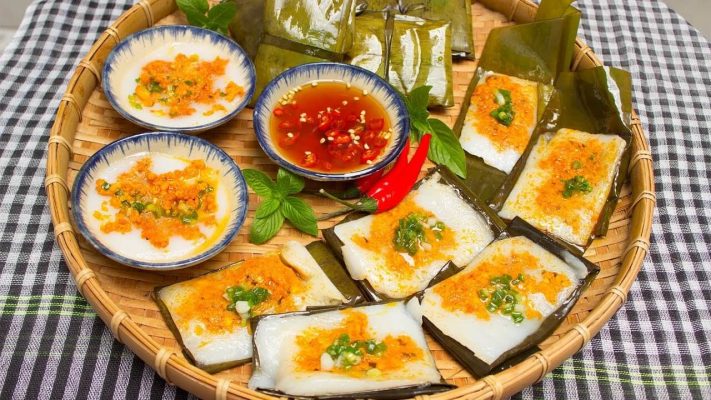
Banh Ram It
In Hue, there is a kind of cake that combines two different types of cakes, which are crispy and sticky, but not greasy because it is dipped with sweet and sour fish sauce, which is a little ram. It seems that ramen cake and little cake are two kinds of cakes that do not mix with each other, but through the talented hands of a Hue woman, little ramen has become a folk dish of Hue known to tourists from near and far.
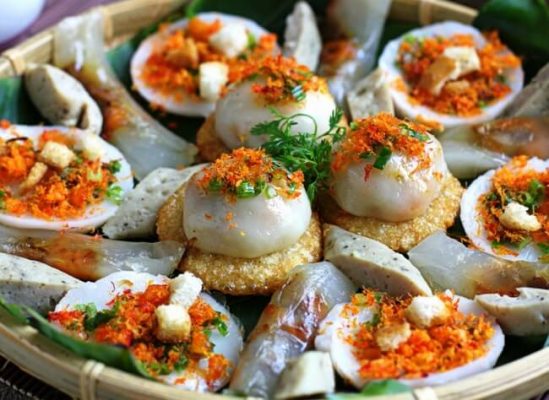
The little ram has two distinct parts: the ram and the little cake. Although the cooking method is different, both parts are made from sticky rice. Sticky rice cakes must be delicious, white, and sticky rice. The glutinous rice is pureed into a powder, mixed with salt, and warm water slowly little by little. Use your hand to knead the dough until it forms a smooth, soft, but not flaky mass, and squeeze it into small balls the size of two fingers. Shrimps whole, chopped bacon, seasoned with sugar, delicious fish sauce, pepper, minced purple onion, add a little oil or fat, simmer for 15 minutes. Rub some cooking oil into your hands, press each dough into a flat shape, take a spoon to scoop the prawns and put them in the middle, and then round them up. Put the cake sparingly in the tray, steam for about 10 minutes after the water boils. The cake is soft and white. Take out the rice cake to cool, cover with banana leaves to prevent the cake from drying, but remember not to cover it to make it sour. Different from cakes, when battering with ramen dough a little less water to make the dough a bit hard. The ramie does not need to be filled, the cake is fried in a greasy pan until it is crispy and dark yellow. Take out the cake and leave it on the absorbent paper to drain the oil. Place a little cake on top of the ram, use the ballast to thin it out, and squeeze it into the ram.
When presenting the plate, the Hue people usually put the little white cake on top and then add a layer of burnt yellow shrimp powder that looks so attractive. The unique feature of the little ram cake is dotted with sweet and sour fish sauce, specially prepared, not too salty, or too sweet, adding the spicy taste of Hue chili slices. The combination of the crispy taste of the ram with the aroma, the softness of the cake, and the sweet and savory taste of the fish sauce has satisfied many diners.
Banh Khoai
Banh Khoai is poured with ground rice flour blended with water and egg yolk, then added pepper, onion, fish sauce, salt, peeled shrimp, sliced grilled beef (or bird), chopped fat, and raw meat bean sprouts. The cake mold is made of round cast iron, the size of two child’s hands with handles. When customers are eating, the restaurant will set the mold on the bakery. Scoop a scoop of egg powder into the grease hot mold. The sound of the dough and the fat is seductive, the flour is ripe, then pick up a piece of roast beef, a small slice of fat, a few shrimp, put in half of the cake, use chopsticks to turn the rest upside downturn the cake into a semicircle, turn the cake to both sides, then place the plate.
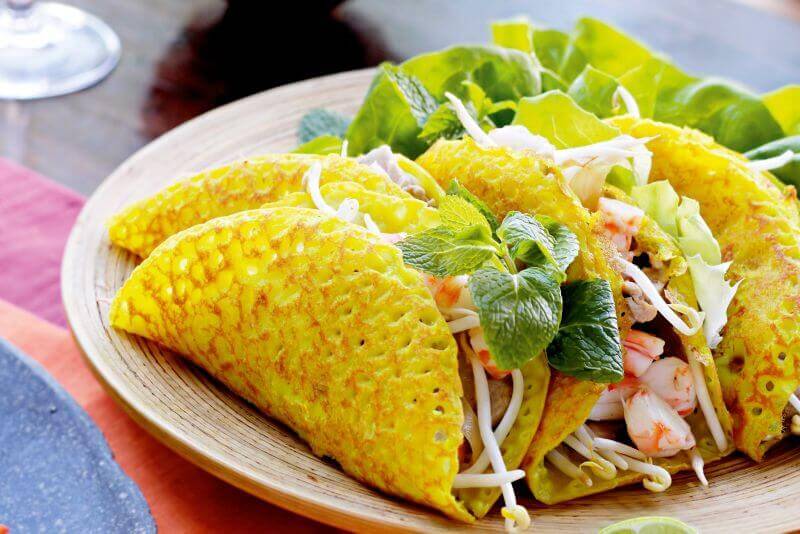
The cake is delicious partly thanks to the broth, a sauce that only good chefs can make. This is the heirloom secret, determining the quality, creating the premium taste of the cake. Hue broth is carefully processed with dozens of ingredients such as semolina, pork liver, sesame (sesame), roasted peanuts,… Thuong Tu restaurant has existed for nearly three or four decades and has become a culinary culture. Hue, captivating tourists, is familiar with the Co Do like mussel rice, the bell of Thien Mu pagoda, the boat of the Perfume River.
Banh Uot Thit Nuong Kim Long
The wet cake is a type of rice paper made with rice flour mixed with filter flour, coated thinner, and used immediately (should be called wet cake, not dried like rice paper). Grilled meat is usually thinly sliced bacon, marinated with pepper, onions, fish sauce, five flavors, and sesame (sesame). After a few hours, the meat is marinated and grilled on a red charcoal stove until it is fully cooked and aromatic. Take this barbecue sandwiched with herbs, bean sprouts, lettuce as a filling to roll wet cake (This dish is almost similar to the style of noodle roll in Hanoi, but in Hanoi is rolled with beef).
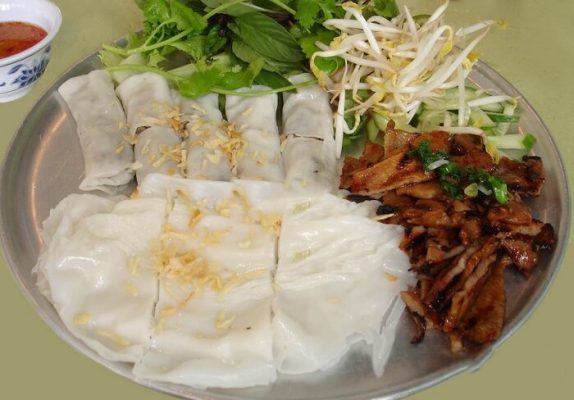
The delicious and attractive Kim Long barbecue wet cake is thanks to its special dipping sauce, which is processed by the owners from pure fish sauce, sugar, lemon, garlic, chili,… as a secret passed down generations. Thanks to the unique flavor of the sauce that Kim Long’s popular dish is known to many tourists, it adds a highlight to the colorful culinary picture of Hue.
With such a unique taste, if you have the opportunity to come to Hue, on the way to visit Linh Mu Pagoda by car or boat, do not forget to stop by Kim Long to enjoy this dish rich in the flavor of this homeland.
Bun Thit Nuong
Hue grilled pork noodles served with cucumber, pickles, raw vegetables, roasted peanuts, scallions,… All are put in a bowl and poured broth. Looking at the bowl of vermicelli you will be conquered immediately by many colors, when you eat, you can feel a lot of flavors at the same time such as the gentle sweetness, the greasy taste of peanuts, sesame, the fresh and sour taste of vegetables, or spicy chili,… A harmonious combination of color and flavor.
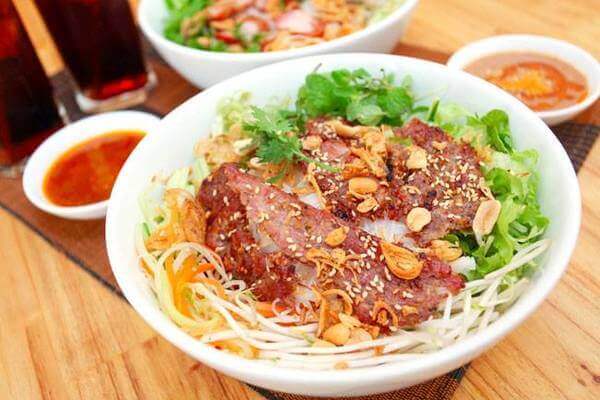
Nem Lui
Coming to Hue without eating spring rolls is very regrettable. The attraction of this famous Hue dish probably comes from a piece of spring rolls that are marinated with a special recipe and then after baking over fragrant embers and broth is made from dozens of originals. Various ingredients such as cooking oil, pork liver, rice powder, sugar, fish sauce, cinnamon chi, anise, and coconut milk. Golden grilled spring rolls with raw vegetables, star fruit, bean sprouts, pineapples, thin sliced green banana slices, and broth are nothing more delicious.
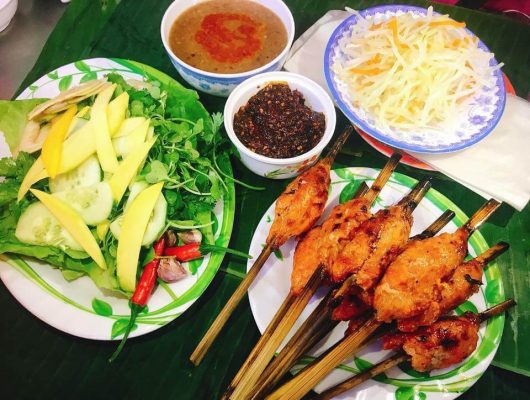
Vegetarian Dishes in Hue
According to incomplete statistics, there are 125 vegetarian dishes in Hue, which shows the richness and diversity of the cuisine of this Kinh land. Hue cuisine has many different styles, divided into many categories such as Royal cuisine, folk cuisine,… In which there is a quite special culinary style here that is Vegetarian Cuisine. The reason that vegetarian cuisine is very developed in Hue is that it is the cultural center of Buddhism in the country.
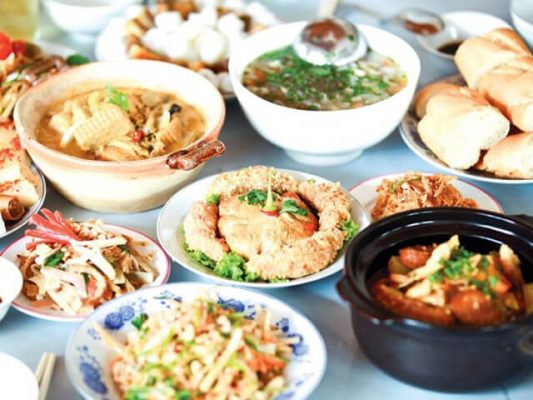
Hue people believe that vegetarianism is benign and calm, so everyone wants to be vegetarian to maintain their freshness mentally. At first, vegetarianism was limited to the Buddhist temples or families, but today it is no longer the “heritage” of the temple, it has spread to folklore and become. a tourism product. In the process of economic integration and development, Hue has many changes, but the vegetarian custom is still circulated and widely popular among most Hue residents.
Banh Canh Hue
Banh Canh Hue is cooked in flour with fish and pork skin, or with minced meat and pellets,… The process is simple and quick: the broth is boiled in a pot, the dough is finished rolling around a round aluminum tube. cutting board. Use a knife to cut into small pieces, and fall into a pot of hot water. When the dough is just cooked, take it out in a bowl, make a broth with chopped pork, fish and onions, add seasoning and eat it hot.
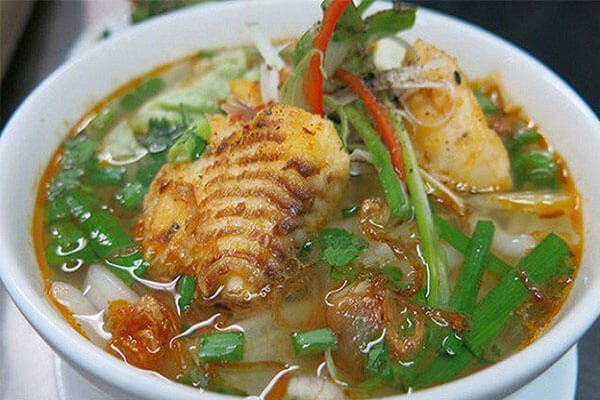
Nam Pho village, Phu Thuong commune, Phu Vang, about 6km from the center of Hue city, has a profession of selling traditional soup porridge. Although it is also a Banh Canh porridge, it’s completely different from the new generation of Banh Canh. Therefore, if you do not know, it is easy for tourists to get confused,… Starting from Nam Pho, going to Vy Da, going to Dong Ba market, going to Thanh Noi,… The Banh Canh line also sold banh mi, little cake, Banh Nam, etc., which are Hue specialty cakes. Nam Pho is a traditional soup made from rice flour (in the past there was no flour), only crushed shrimp to mix eggs. The soup bowl is flat, the broth is clear and thick, and fragrant,…
Types of tea Hue
Hue is not only attracted by the serene beauty and moss of the temples and mausoleums but when coming here, visitors are also attracted by the richest and most diverse culinary treasure of Vietnam. In which, Hue tea is considered the “heart” dish of many tourists when coming to the ancient capital.
Across the alleys in Hue city, walking a few hundred steps, you found a teabag. And although it is a bag of unnamed seaweed tea, the delicacy, and ingenuity of the smooth, smooth taro teacups, soft filter powder, fragrant corn teacups with a sweet and young sweet taste,… generic by the name of Hue tea that we eat anywhere else.
There will never be enough stomach to taste all the delicious flavors in the Hue tea menu. Because if only the royal tea has up to 36 types, each has its flavor. If you like sweet and fragrant flavors, you can choose lotus seed tea, green bean tea, and if you like fruit, pineapple green tea, pomegranate tea, mulberry tea, and chamomile tea are great choices.
You can enjoy typical tea dishes of Hue at Dong Ba Market, Alley Tea Shop (Hung Vuong Street), with filtered powdered tea wrapped with roasted meat can be eaten at Mo Ton Dich (Thuong Bac Park, Dinh Tien Hoang – Tran Hung Dao intersection, the shop only sells from 4:00 pm), corn tea can be enjoyed at Con Hen.
Chè bột lọc heo quay
Powdered tea is in the form of small round pellets, made of flour, when boiled, the powder is from opaque white to clear white, served with sugar water and this is a tea that is always eaten cold or warm. eat cold. Roast meat filter tea is made from pieces of roasted pork, cut square with small dice (including pork skin, meat) covered with glutinous powder, and then poured into sugar to boil into tea. This tea has both a sweet and salty taste, so it is not greasy to eat.
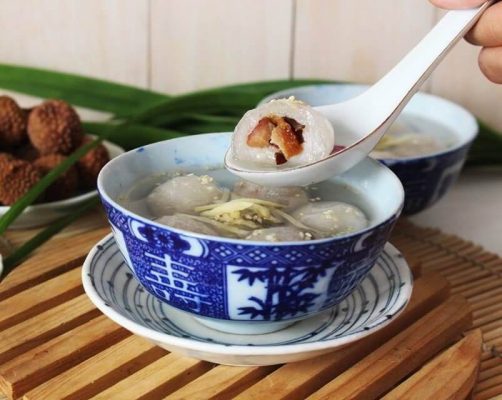
Chè Bắp
In Hue, there is a delicious Con Hen corn tea that is not available anywhere. This land has an alluvial ground of several tens of hectares, where people grow corn almost all year round. Corn in Con Hen is delicious because it is grown on a thick alluvial layer that is deposited through each flood.
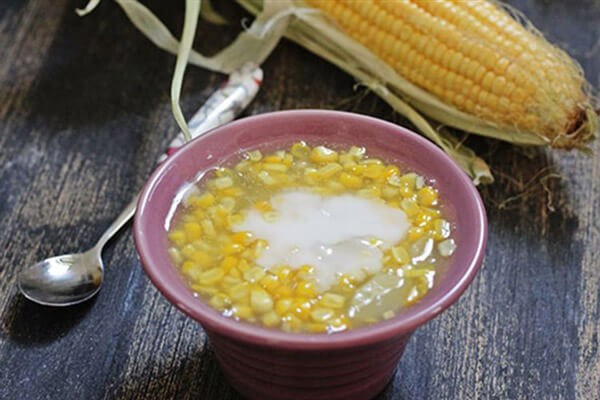
Chè Hạt Sen
Is a highly refined tea, processed from lotus seeds in Tinh Tam lake. Lotus tea cooked in Hue style is steamed, then cooked with white sugar or clear rock sugar until it boils gently. The sweetness of the sugar is enough to penetrate the lotus seeds and go out to the kitchen. To have a delicious teapot, the cook has to keep watch for the fire to burn just right, stirring, mixing gently, time is just enough for the lotus seeds “not old, not young”. When cooking, lotus seeds will lose their natural aroma. Young cooking, the lotus scent will not radiate.
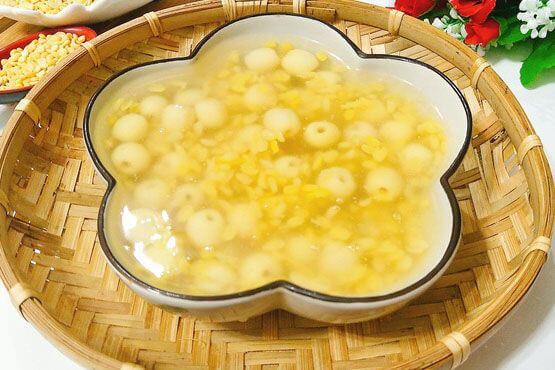
Chè Khoai Tía
This dish is favored by many guests for its color and taste. The tea is cooked from purple taro, then cooked with coconut water, and let it simmer until it matches. Add the sugar just enough, but not to lose the coconut flavor. Tea is fragrant and sweet.
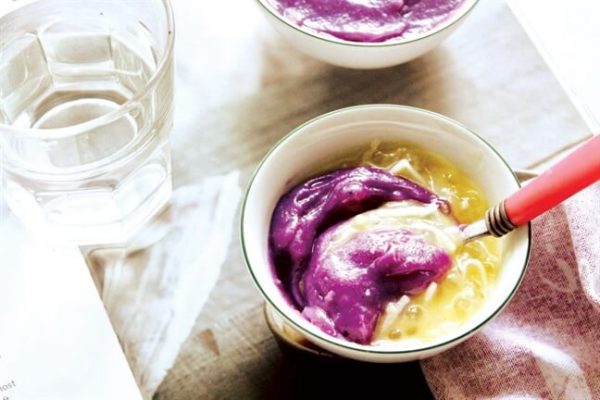
Chè Đậu
These are also types of tea originating in Hue for a long time. The tea is cooked softly but still has the beans intact. Soft tea adds crushed roasted peanuts and coconut water. Coconut milk is added later to increase the fat taste of tea, roasted peanuts with a subtle aroma.
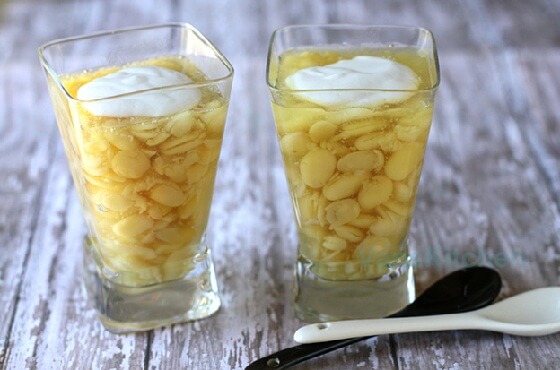
Banh Chung Nhat Le
This is a famous dish in Hue and originated from Nhat Le Street in Noi City, where dozens of bakeries are gathered. The cake is fragrant, delicious, and delicious due to the delicate combination of bean paste, meat (fat and lean) with glutinous rice, and spices such as pepper, or onions.
Five-color cake (Bánh In)
Five-color cake, also known as “Banh In”, this family has many types: bamboo shoot cake, glutinous rice cake, fluorescent flour cake, green bean cake, lotus cake,… each cake has the same type of flour as its name suggests. it. The cake is wrapped in mirror paper of all colors but has specific regulations, for example, the green color is hopefully green bean cake, the yellow color is a glutinous cake,… and pressed, the face of the cake is difficult to carve. Tho, Phuc, Loc shapes and wrapped in five-color paper. This is a type of cake to use on Tet, for worshiping and hospitality. Due to its low value, many people prefer it.
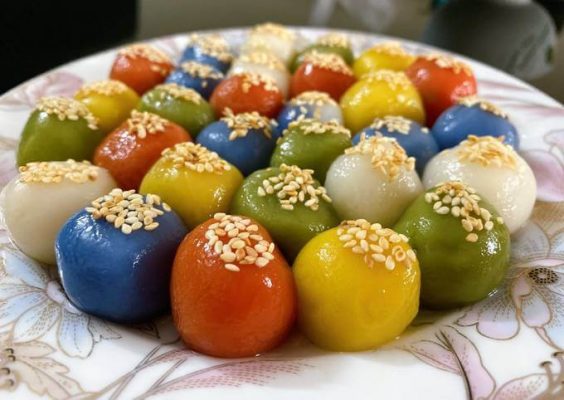
Currently, in Hue, there are two famous bakery shops: Hong Phuc shop on Phan Dang Luu Street, Ba Bon shop on Nguyen Thien Thuat Street, especially on the full moon day, the first day of Bao Thanh bakery on Tran Hung street. Dao also sells this kind of cake.
Hue specialties bought as gifts
Hue Sour Shrimp
Sour shrimp in the right “tune” must be made from very fresh brackish shrimp, especially the shrimp brought up from Cau Hai. Choose shrimp that are even and relatively large. Shrimps are head off, washed, soaked for a while in alcohol. Then take out and drain, mix well with the additives: galangal, garlic, red pepper, young bamboo shoots, sticky rice, delicious fish sauce. In the additives, galangal plays the most important role, so it must be used more than all. Thinly sliced garlic, sliced chili, long and thin-sliced, separately, and sliced bamboo shoots. Shrimp is best incubated in a ceramic jar. When ripe, bring it together with a little honey. Can add a little galangal and then put it into glass jars or plastic jars. So in a jar of sour shrimp, we see all the colors: white, yellow, pink, red; All kinds of flavors: sweet, fatty, nutty, spicy, sour, bitter, hot, and cool, meaning both positive and negative. All blended to create a seductive fragrance. The incubation process lasts from 7-10 days, but must be kept in a clean, cool room. If more sophisticated, one can bury it in the ground to keep a constant temperature for the fermentation process. The more stable the temperature, the more fragrant and sweet the shrimp are.
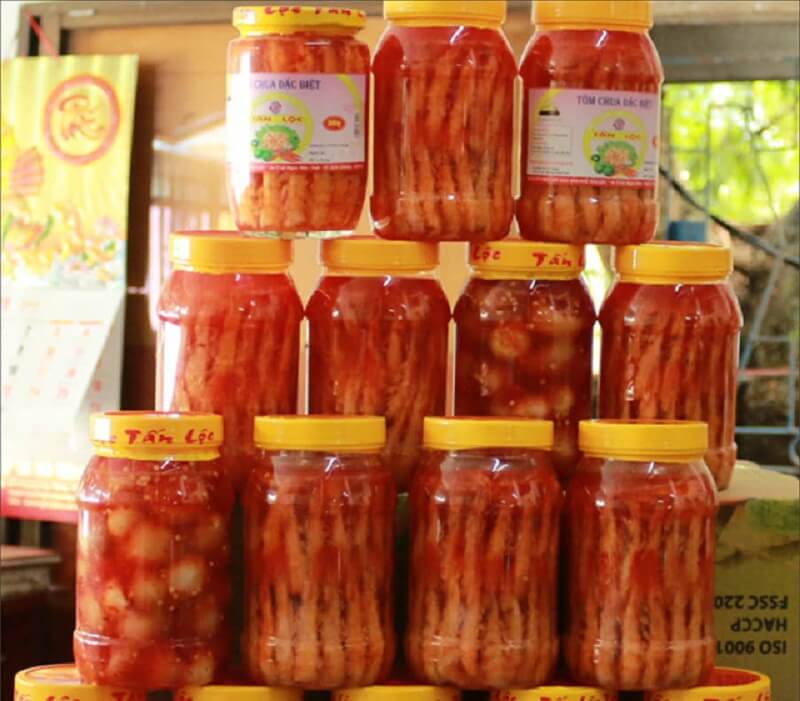
Sesame
Sesame is a marshmallow, made from malt mixed with peanut oil (oil from peanuts), with sesame covered around the candy, cut into small squares (cellophane bags) wrapped in a box. Sesame candy is one of the specialties that has become a cultural symbol of Hue.
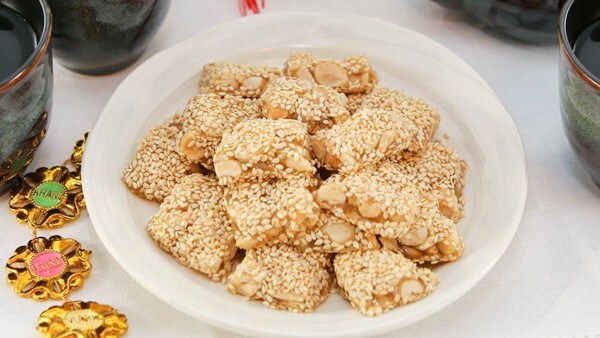
Festival in Hue
Thua Thien Hue is a land with cultural traditions, although not as old as in the North, but also has more than 700 years of history. Since the Nguyen Lord placed the capital here until the end of the Nguyen Dynasty (1945), it can be said that Hue is the gathering place of great cultural activists, a meeting place of East and West ideological flows. antique needle. Hue culture has traditionally poured in from the North, according to the people who settled in the new land. Here still exist the Cham people with Indian culture. And later Western culture also had the opportunity to penetrate the Nguyen Lords. The traditional festivals are maintained and developed from those cultural sources.
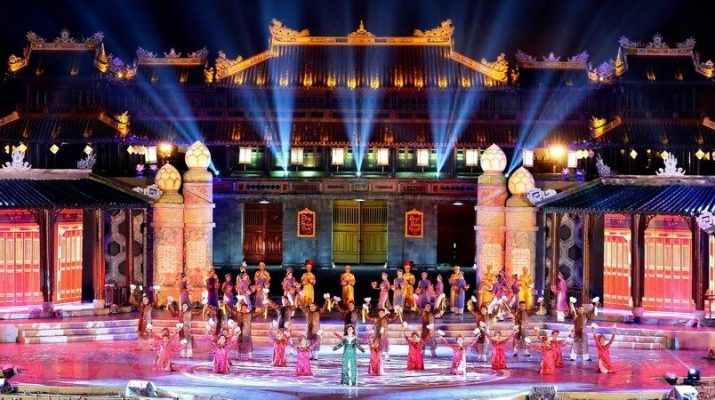
Festivals of all kinds are a need for cultural activities of Thua Thien Hue People has become a tradition. An overview of the festival and the festival participation of the residents of this region, we will see that the festival in Thua Thien Hue is not as rich as the North, but also quite diverse, there are two types of festivals: bow festival family and folk festivals. The royal festival reflected the ritual activities of the Nguyen Dynasty, mostly focusing on “ceremony” rather than “festival”. Folk festivals include a variety of types, including some typical festivals as follows: Hue Nam Festival (Hon Chen Palace), also known as the procession of the goddess Thien YA Na according to people’s beliefs. In the old Cham Pa, the festival commemorates the births of traditional professions, the festival commemorates the ancestors of the village. During ceremonial occasions, many useful cultural activities such as boat racing, tug of war, wrestling,… are also organized and attract a lot of viewers.
Some tourism schedules of Hue
Tour: Hue – Da Nang – Hoi An
The itinerary will be arranged from the starting date in Hue, depending on where you live, you actively plan to get to Hue on time. This schedule is suitable for renting a motorbike in Hue to run by many places. You can cut the schedule to better fit your plan.
Day 1: Discover the Imperial Citadel of Hue
Wake up around the hotel to find out if there are any vermicelli, make a bowl for breakfast, make a cup of coffee and start exploring Hue. From the hotel, rent a cyclo pass through Truong Tien bridge to Hue imperial city.
Buy a ticket to explore the inner city, because the area is quite large, it may take a few hours or an entire morning to fully explore the citadel. After finishing, go out to find some famous restaurants to enjoy delicious food in Hue. Near the royal citadel, there is Lac Thien restaurant, which is quite famous for Thuong Tu’s delicious cake.
Early in the afternoon, from the center of Hue city, you rent a motorbike to go to Thien Mu pagoda, the road running along the Perfume River is very cool and beautiful. Spend about 1 hour to visit and take pictures at the pagoda, from here running another ten kilometers, you will reach Huyen Khong Son Thuong, a temple located on the mountain with a very beautiful landscape. From Huyen Khong, Son Thuong comes back to Hue to go through some garden houses, if you are interested, you can visit.
In the evening, go back to the center of Hue city, enjoy the typical cakes of Hue. If you go on weekends, you can walk around the night market, drink beer, and listen to music.
Day 2: Tam Giang Lagoon – Phu Cam Church – Thanh Toan Ngoi Bridge
Get up for breakfast, drink coffee and depart for Tam Giang Lagoon. This place is more than 30km from the center of Hue city, at noon stay to eat at restaurants on the lagoon, rest, and then return to Hue in the afternoon.
In the afternoon, back to the center of Hue city, visit Phu Cam church, and then go to Thanh Toan tile bridge. These are two beautiful places in Hue, not too far away so it is completely possible to go in one afternoon.
Day 3: Bach Ma – Lang Co
This day, You will go to Bach Ma, Lang Co, but the journey is quite far, so you need to go early to return to the center of Hue city.
Get up for breakfast, depart in the direction of NH1A towards Da Nang, when you reach the section near Da Bac, turn to Ho Truoi, here you need to take another boat trip to reach Truc Lam Bach Ma Monastery. The monastery is quite beautiful with its back leaning on the Bach Ma mountain range, face down towards Truoi Lake.
After exploring the Zen Monastery, return to the direction of NH1A to go to Bach Ma National Park, on the way go through Cau Hai lagoon, the largest lagoon in the Tam Giang lagoon system.
Afternoon back to Hue to rest.
Day 4: Hue – Da Nang
From Hue to Da Nang you can go by car or train, all the time is only about 3 hours. However, if you want to admire the wonderful scenery of Lang Co Bay and the beautiful beaches of Da Nang, choose the train option. The train departs from Hue around 10:30 and arrives at Đa Nang at 13:30, you can buy train tickets online and go straight to the station to print tickets on the train.
Day 5 ++: Depending on your time, you arrange to explore Da Nang, or explore Hoi An accordingly.
Related Article: Traveling experience in Ban Gioc Waterfall that tourist should know
Let start your trip to Hue with us! If you have any feedback or need help, please send an email through vietnamreviewer.contact@gmail.com!
Noted: All information and pictures are collected!

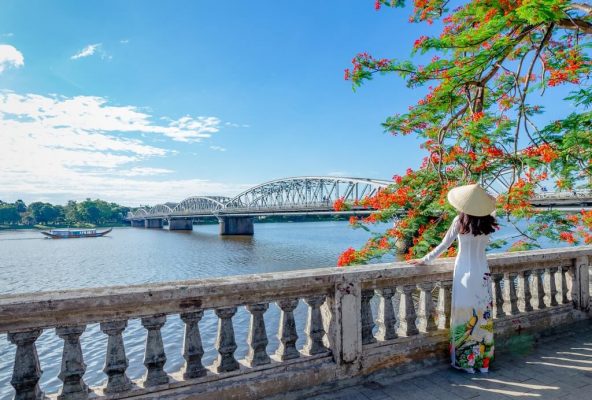
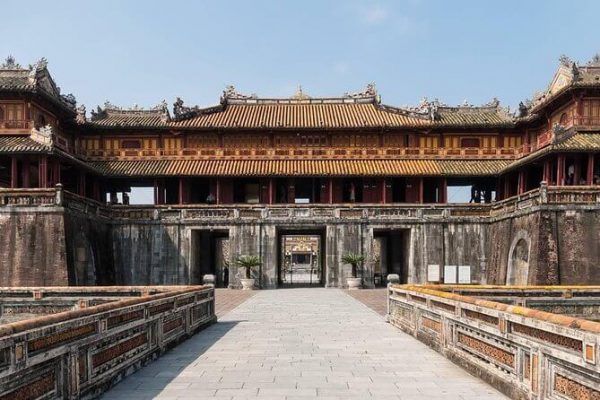
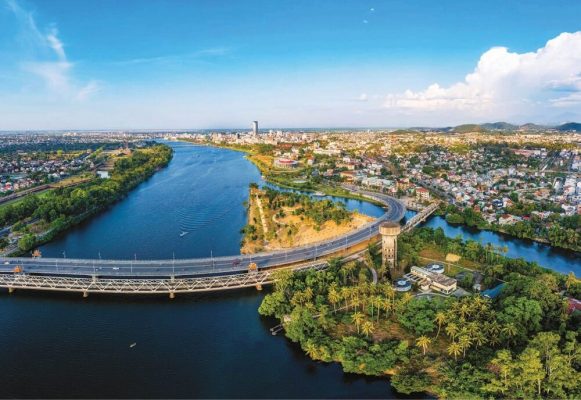
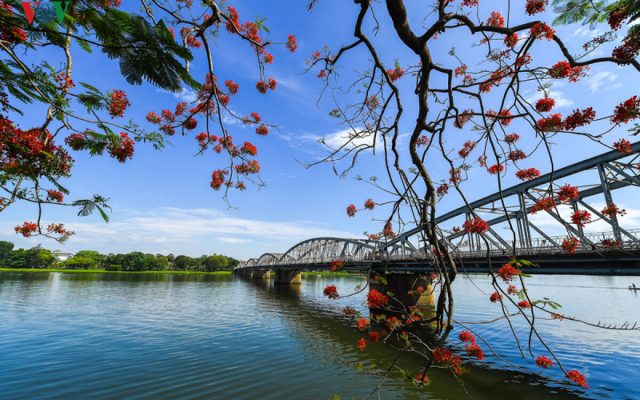
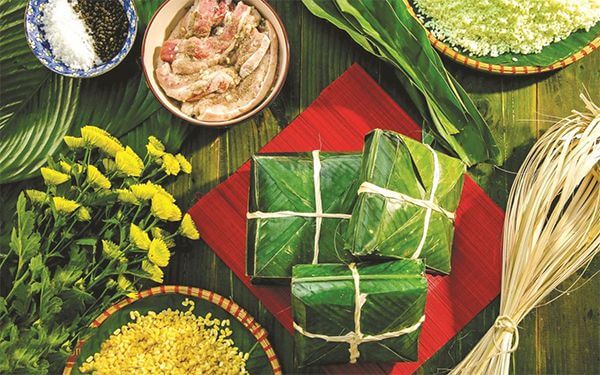

Nice!